Mybatis笔记
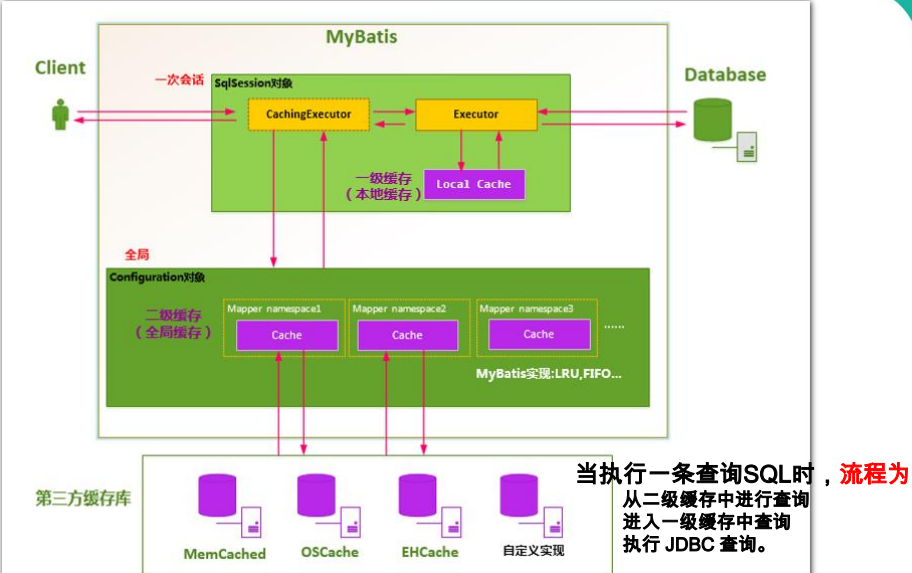
注:本人学习了 Up主“狂神说”的SSM的专题(https://www.bilibili.com/video/BV1NE411Q7Nx?from=search&seid=10507764079779535816)和尚硅谷SSM专题(https://www.bilibili.com/video/BV1mW411M737?from=search&seid=10507764079779535816),结合俩者总结的笔记(仅供参考),
Mybatis的介绍
什么是mybatis
-
MyBatis 是一款优秀的持久层框架
-
MyBatis 避
免了几乎所有的 JDBC 代码和手动设置参数以及获取结果集的过程
-
MyBatis 可以使用简单的 XML 或注解来配置和映射原生信息,将接口和 Java 的 实体类 【Plain Old Java Objects,普通的 Java对象】映射成数据库中的记录。
-
MyBatis 本是apache的一个开源项目ibatis, 2010年这个项目由apache 迁移到了google code,并且改名为MyBatis 。
-
2013年11月迁移到Github .
-
Mybatis官方文档 : http://www.mybatis.org/mybatis-3/zh/index.html
-
GitHub : https://github.com/mybatis/mybatis-3
持久化
什么是持久化
持久化是将程序数据在持久状态和瞬时状态间转换的机制。
- 即把数据(如内存中的对象)保存到可永久保存的存储设备中(如磁盘)。持久化的主要应用是将内存中的对象存储在数据库中,或者存储在磁盘文件中、XML数据文件中等等。
- JDBC就是一种持久化机制。文件IO也是一种持久化机制。
- 在生活中 : 将鲜肉冷藏,吃的时候再解冻的方法也是。将水果做成罐头的方法也是。
为什么需要持久化
- 内存断电后数据会丢失,但有一些对象是无论如何都不能丢失的,比如银行账号等,遗憾的是,人们还无法保证内存永不掉电。
- 内存过于昂贵,与硬盘、光盘等外存相比,内存的价格要高2~3个数量级,而且维持成本也高,至少需要一直供电吧。所以即使对象不需要永久保存,也会因为内存的容量限制不能一直呆在内存中,需要持久化来缓存到外存。
持久层
什么是持久层
-
完成持久化工作的代码块 . ----> dao层 【DAO (Data Access Object) 数据访问对象】
-
大多数情况下特别是企业级应用,数据持久化往往也就意味着将内存中的数据保存到磁盘上加以固化,而持久化的实现过程则大多通过各种关系数据库来完成。
-
不过这里有一个字需要特别强调,也就是所谓的“层”。对于应用系统而言,数据持久功能大多是必不可少的组成部分。也就是说,我们的系统中,已经天然的具备了“持久层”概念?也许是,但也许实际情况并非如此。之所以要独立出一个“持久层”的概念,而不是“持久模块”,“持久单元”,也就意味着,我们的系统架构中,应该有一个相对独立的逻辑层面,专注于数据持久化逻辑的实现.
-
与系统其他部分相对而言,这个层面应该具有一个较为清晰和严格的逻辑边界。【说白了就是用来操作数据库存在的!】
为什么需要mybatis
-
Mybatis就是帮助程序猿将数据存入数据库中 , 和从数据库中取数据 .
-
传统的jdbc操作 , 有很多重复代码块 .比如 : 数据取出时的封装 , 数据库的建立连接等等... , 通过框架可以减少重复代码,提高开发效率 .
-
MyBatis 是一个半自动化的ORM框架 (Object Relationship Mapping) -->对象关系映射
-
所有的事情,不用Mybatis依旧可以做到,只是用了它,所有实现会更加简单!技术没有高低之分,只有使用这个技术的人有高低之别
-
MyBatis的优点
- 简单易学:本身就很小且简单。没有任何第三方依赖,最简单安装只要两个jar文件+配置几个sql映射文件就可以了,易于学习,易于使用,通过文档和源代码,可以比较完全的掌握它的设计思路和实现。
- 灵活:mybatis不会对应用程序或者数据库的现有设计强加任何影响。sql写在xml里,便于统一管理和优化。通过sql语句可以满足操作数据库的所有需求。
- 解除sql与程序代码的耦合:通过提供DAO层,将业务逻辑和数据访问逻辑分离,使系统的设计更清晰,更易维护,更易单元测试。sql和代码的分离,提高了可维护性。
- 提供xml标签,支持编写动态sql。
第一个Mybatis程序
思路流程:搭建环境-->导入Mybatis--->编写代码--->测试
1、搭建实验数据库
-
CREATE DATABASE `mybatis`; USE `mybatis`; DROP TABLE IF EXISTS `user`; CREATE TABLE `user` ( `id` int(20) NOT NULL, `name` varchar(30) DEFAULT NULL, `pwd` varchar(30) DEFAULT NULL, PRIMARY KEY (`id`) ) ENGINE=InnoDB DEFAULT CHARSET=utf8; insert into `user`(`id`,`name`,`pwd`) values (1,'狂神','123456'),(2,'张三','abcdef'),(3,'李四','987654');
2、导入MyBatis相关 jar 包
<dependency>
<groupId>org.mybatis</groupId>
<artifactId>mybatis</artifactId>
<version>3.5.2</version>
</dependency>
<dependency>
<groupId>mysql</groupId>
<artifactId>mysql-connector-java</artifactId>
<version>5.1.47</version>
</dependency>
3、编写MyBatis核心配置文件(mybatis-config.xml)
<?xml version="1.0" encoding="UTF-8" ?>
<!DOCTYPE configuration
PUBLIC "-//mybatis.org//DTD Config 3.0//EN"
"http://mybatis.org/dtd/mybatis-3-config.dtd">
<configuration>
<environments default="development">
<environment id="development">
<transactionManager type="JDBC"/>
<dataSource type="POOLED">
<property name="driver" value="com.mysql.jdbc.Driver"/>
<property name="url" value="jdbc:mysql://localhost:3306/mybatis?useSSL=true&useUnicode=true&characterEncoding=utf8"/>
<property name="username" value="root"/>
<property name="password" value="123456"/>
</dataSource>
</environment>
</environments>
<!--每个mapper.xml文件都需要在mybatis核心配置文件中注册 -->
<mappers>
<!-- resource 绑定mapper时,需要以'/'的路径,不能使用以'.'的路径 -->
<mapper resource="com/kuang/dao/userMapper.xml"/>
<!--
以下是错误写法
<mapper resource="com.kuang.dao.userMapper.xml"/>
-->
</mappers>
</configuration>
4、编写MyBatis工具类
SqlSessionFactoryBuilder----》sqlSessionFactory -----》sqlSession
import org.apache.ibatis.io.Resources;
import org.apache.ibatis.session.SqlSession;
import org.apache.ibatis.session.SqlSessionFactory;
import org.apache.ibatis.session.SqlSessionFactoryBuilder;
import java.io.IOException;
import java.io.InputStream;
public class MybatisUtils {
private static SqlSessionFactory sqlSessionFactory;
//获取SqlSessionFactory对象
static {
try {
String resource = "mybatis-config.xml";
InputStream inputStream = Resources.getResourceAsStream(resource);
sqlSessionFactory = new SqlSessionFactoryBuilder().build(inputStream);
} catch (IOException e) {
e.printStackTrace();
}
}
//获取SqlSession连接
public static SqlSession getSession(){
return sqlSessionFactory.openSession();
}
}
5、创建实体类
public class User {
private int id; //id
private String name; //姓名
private String pwd; //密码
//构造,有参,无参
//set/get
//toString()
}
6、编写Mapper接口类
import com.kuang.pojo.User;
import java.util.List;
public interface UserMapper {
List<User> selectUser();
}
7、编写Mapper.xml配置文件
Mapper.xml 一般和对应的Mapper接口放在同一个目录
例如:UserMapper接口在com.kuang.dao
UserMapper.xml也在com.kuang.dao目录下
<?xml version="1.0" encoding="UTF-8" ?>
<!DOCTYPE mapper
PUBLIC "-//mybatis.org//DTD Mapper 3.0//EN"
"http://mybatis.org/dtd/mybatis-3-mapper.dtd">
<!--
namespace:名称空间;指定为接口的全类名
id:唯一标识
resultType:返回值类型
#{id}:从传递过来的参数中取出id值
public Employee getEmpById(Integer id);
select * from user where id = #{id}
-->
<mapper namespace="com.kuang.dao.UserMapper">
<select id="selectUser" resultType="com.kuang.pojo.User">
select * from user
</select>
</mapper>
Maven静态资源过滤问题
一般需要在maven工程下的pol.xml总配置如下:
<!-- 防止我们的xml或propertis文件导出失败-->
<resources>
<resource>
<directory>src/main/java</directory>
<includes>
<include>**/*.properties</include>
<include>**/*.xml</include>
</includes>
<filtering>true</filtering>
</resource>
<resource>
<directory>src/main/resources</directory>
<includes>
<include>**/*.properties</include>
<include>**/*.xml</include>
</includes>
<filtering>true</filtering>
</resource>
</resources>
CRUD操作
分析Mapper.xml配置文件
注意:配置文件中namespace中的名称为对应Mapper接口或者Dao接口的完整包名,必须一致!
/**
- 测试增删改
- 1、mybatis允许增删改直接定义以下类型返回值
Integer、Long、Boolean、void- 2、我们需要手动提交数据
sqlSessionFactory.openSession();===》手动提交sqlSessionFactory.openSession(true);===》自动提交*/
<?xml version="1.0" encoding="UTF-8" ?>
<!DOCTYPE mapper
PUBLIC "-//mybatis.org//DTD Mapper 3.0//EN"
"http://mybatis.org/dtd/mybatis-3-mapper.dtd">
<!--
namespace:名称空间;指定为接口的全类名
id:唯一标识
resultType:返回值类型
#{id}:从传递过来的参数中取出id值
public Employee getEmpById(Integer id);
select * from user where id = #{id}
-->
<mapper namespace="com.kuang.dao.UserMapper">
<select id="selectUser" resultType="com.kuang.pojo.User">
select * from user
</select>
</mapper>
select
-
select标签是mybatis中最常用的标签之一
-
select语句有很多属性可以详细配置每一条SQL语句
-
- SQL语句返回值类型。【完整的类名或者别名】
- 传入SQL语句的参数类型 。【万能的Map,可以多尝试使用】
- 命名空间中唯一的标识符
- 接口中的方法名与映射文件中的SQL语句ID 一一对应
- id
- parameterType
- resultType
练习1:根据id查询用户
1、在UserMapper中添加对应方法
public interface UserMapper {
//查询全部用户
List<User> selectUser();
//根据id查询用户
User selectUserById(int id);
}
2、在UserMapper.xml中添加Select语句
<select id="selectUserById" resultType="com.kuang.pojo.User">
select * from user where id = #{id}
</select>
3、测试类中测试
@Test
public void tsetSelectUserById() {
SqlSession session = MybatisUtils.getSession(); //获取SqlSession连接
UserMapper mapper = session.getMapper(UserMapper.class);
User user = mapper.selectUserById(1); //在方法中传递参数
System.out.println(user);
session.close();
}
type:搭配resultMap ===》<resultMap type="employee" id="MySimpleEmp">
JavaType:属性是一个对象 ===》<association property="dept" javaType="com.atguigu.mybatis.bean.Department">
offType:搭配集合中的类型 ===》<collection property="emps" ofType="com.atguigu.mybatis.bean.Employee">
#### resultType
当使用resultType做SQL语句返回结果类型处理时,对于SQL语句查询出的字段在相应的pojo中必须有和它相同的字段对应,mybatis**自动完成映射**(从查询结果的字段名 映射到 javaBean的属性名,然后进行封装)。
**情况一**:返回List集合,resultType要写集合中元素的类型
```java
public List<Employee> getEmpsByLastNameLike(String lastName);
<!-- public List<Employee> getEmpsByLastNameLike(String lastName); -->
<!--resultType:如果返回的是一个集合,要写集合中元素的类型 -->
<select id="getEmpsByLastNameLike" resultType="com.atguigu.mybatis.bean.Employee">
select * from tbl_employee where last_name like #{lastName}
</select>
@Test
public void test8() {
SqlSession sqlSession = MybatisUtils.getSqlSession();
try {
EmployeeMapper mapper = sqlSession.getMapper(EmployeeMapper.class);
List<Employee> employees = mapper.getEmpByLastNameLIke("%三%");
for (Employee emp : employees) {
System.out.println(emp);
}
sqlSession.commit(); //提交事务
} finally {
sqlSession.close();
}
}
测试结果

情况二:返回一条记录的map; resultType="map" ; key就是列名,值就是对应的值
public Map<String, Object> getEmpByIdReturnMap(Integer id);
<!--public Map<String, Object> getEmpByIdReturnMap(Integer id); -->
<select id="getEmpByIdReturnMap" resultType="map">
select * from tbl_employee where id=#{id}
</select>
@Test
public void test9() {
SqlSession sqlSession = MybatisUtils.getSqlSession();
try {
EmployeeMapper mapper = sqlSession.getMapper(EmployeeMapper.class);
Map<String, Object> employee = mapper.getEmpByIdReturnMap(1);
System.out.println(employee);
sqlSession.commit();
} finally {
sqlSession.close();
}
}
测试结果

情况三:多条记录封装到一个map中,resultType=map或者resultType = employee
//多条记录封装一个map:Map<Integer,Employee>:键是这条记录的主键,值是记录封装后的javaBean
//@MapKey:告诉mybatis封装这个map的时候使用哪个属性作为map的key
@MapKey("lastName")
public Map<String, Employee> getEmpByLastNameLikeReturnMap(String lastName);
<!--public Map<Integer, Employee> getEmpByLastNameLikeReturnMap(String lastName); -->
<select id="getEmpByLastNameLikeReturnMap" resultType="employee">
select * from tbl_employee where last_name like #{lastName}
</select>
测试结果:

resultMap
自定义返回结果集
<!-- resultMap:自定义结果集映射规则; -->
<!-- public Employee getEmpById(Integer id); -->
<select id="getEmpById" resultMap="MySimpleEmp">
select * from tbl_employee where id=#{id}
</select>
<!--自定义某个javaBean的封装规则
type:自定义规则的Java类型
id:唯一id方便引用
-->
<resultMap type="employee" id="MySimpleEmp">
<!--指定主键列的封装规则
id定义主键会底层有优化;
column:指定数据表中的哪一列
property:指定对应的javaBean属性
-->
<id column="id" property="id"/>
<!-- 定义普通列封装规则 -->
<result column="last_name" property="lastName"/>
<!-- 其他不指定的列会自动封装:我们只要写resultMap就把全部的映射规则都写上。 -->
<result column="email" property="email"/>
<result column="gender" property="gender"/>
</resultMap>
场景一(多对一):
查询Employee的同时查询员工对应的部门
Employee===Department
一个员工有与之对应的部门信息;
id last_name gender d_id did dept_name (private Department dept;)
三种方法:①联合查询:级联属性封装结果集
②结果嵌套查询
③分组/分步嵌套查询
联合查询:
步骤一:建表
数据表:tbl_dept
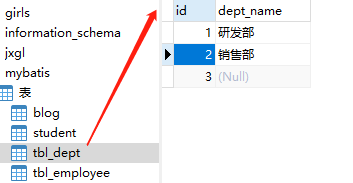
数据表:
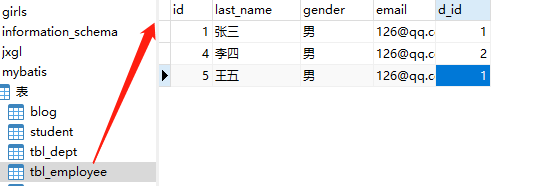
步骤二:编写实体类
public class Employee {
private Integer id;
private String lastName;
private String gender;
private String email;
private Department dept;
//get,set方法
}
public class Department {
private Integer id;
private String departmentName;
//get,set方法
}
步骤三:编写Mapper接口和Mapper.xml的SQL语句
<!-- 接口中的方法: public Employee getEmpAndDept(Integer id);-->
<select id="getEmpAndDept" resultMap="MyDifEmp">
SELECT e.id id,e.last_name last_name,e.gender gender,e.d_id d_id,
d.id did,d.dept_name dept_name FROM tbl_employee e,tbl_dept d
WHERE e.d_id=d.id AND e.id=#{id}
</select>
<!--
联合查询:级联属性封装结果集
-->
<resultMap type="com.atguigu.mybatis.bean.Employee" id="MyDifEmp">
<id column="id" property="id"/>
<result column="last_name" property="lastName"/>
<result column="gender" property="gender"/>
<result column="did" property="dept.id"/>
<result column="dept_name" property="dept.departmentName"/>
</resultMap>
注意点:①select 标签中需要得到全部的数据,resultMap 标签中的数据是在select标签的基础上获得的
② property="dept.id",dept是employee的属性(Department对象类型),dept.id-->dept对象的id属性
结果嵌套查询
数据表和实体同上
步骤三:编写Mapper接口和Mapper.xml的SQL语句
<select id="getEmpAndDept" resultMap="MyDifEmp2">
SELECT e.id id, e.last_name last_name, e.gender gender, e.email email,e.d_id d_id,d.id did
,d.dept_name dept_name
FROM tbl_employee e,tbl_dept d
WHERE e.d_id = d.id AND e.id = #{id};
</select>
<!--
使用association定义关联的单个对象的封装规则;
-->
<resultMap type="com.atguigu.mybatis.bean.Employee" id="MyDifEmp2">
<id column="id" property="id"/>
<result column="last_name" property="lastName"/>
<result column="gender" property="gender"/>
<!-- association可以指定联合的javaBean对象
property="dept":指定哪个属性是联合的对象
javaType:指定这个属性对象的类型[不能省略]
-->
<association property="dept" javaType="com.atguigu.mybatis.bean.Department">
<id column="did" property="id"/>
<result column="dept_name" property="departmentName"/>
</association>
</resultMap>
注意点:①select 标签中需要得到全部的数据,resultMap 标签中的数据是在select标签的基础上获得的
②association可以指定联合的javaBean对象 javaType:指定这个属性对象的类型
分组/分步嵌套查询
数据表和实体同上
步骤三:编写Mapper接口和Mapper.xml的SQL语句
<select id="getEmpByIdStep" resultMap="MyEmpByStep">
select * from tbl_employee where id=#{id}
</select>
<resultMap type="com.atguigu.mybatis.bean.Employee" id="MyEmpByStep">
<id column="id" property="id"/>
<result column="last_name" property="lastName"/>
<result column="email" property="email"/>
<result column="gender" property="gender"/>
<!-- association定义关联对象的封装规则
select:表明当前属性是调用select指定的方法查出的结果
column:指定将哪一列的值传给这个方法
流程:使用select指定的方法(传入column指定的这列参数的值)查出对象,并封装给property指定的属性
-->
<association property="dept"
select="com.atguigu.mybatis.dao.DepartmentMapper.getDeptById"
column="d_id">
</association>
</resultMap>
其中,DepartmentMapper.xml:
<mapper namespace="com.atguigu.dao.DepartmentMapper">
<!--
public Department getDeptById(Integer id);
-->
<select id="getDeptById" resultType="department">
select id,dept_name departmentName from tbl_dept where id = #{id}
</select>
</mapper>
懒加载
-
N+1问题:假设现在有N个关联关系完成了级联,那么只要再引入一个关联关系,就变成了N+1级联,所有级联的SQL都会被执行,显然会有很多我们不需要的数据被加载进来,这就造成了极大的资源浪费。
-
引入延迟加载的目的:为了处理N+1问题(级联加载的性能问题)
aggressiveLazyLoading = true,mybatis 是按层级延时加载
aggressiveLazyLoading = false,mybatis 按需求加载。
<!--显示的指定每个我们需要更改的配置的值,即使他是默认的。防止版本更新带来的问题 -->
<!--开启懒加载-->
<setting name="lazyLoadingEnabled" value="true"/>
<!-- 当启用时,有延迟加载属性的对象在被调用时将会完全加载任意属性 . 默认:true-->
<setting name="aggressiveLazyLoading" value="false"/>
若没有开启懒加载,会加载不需要的数据
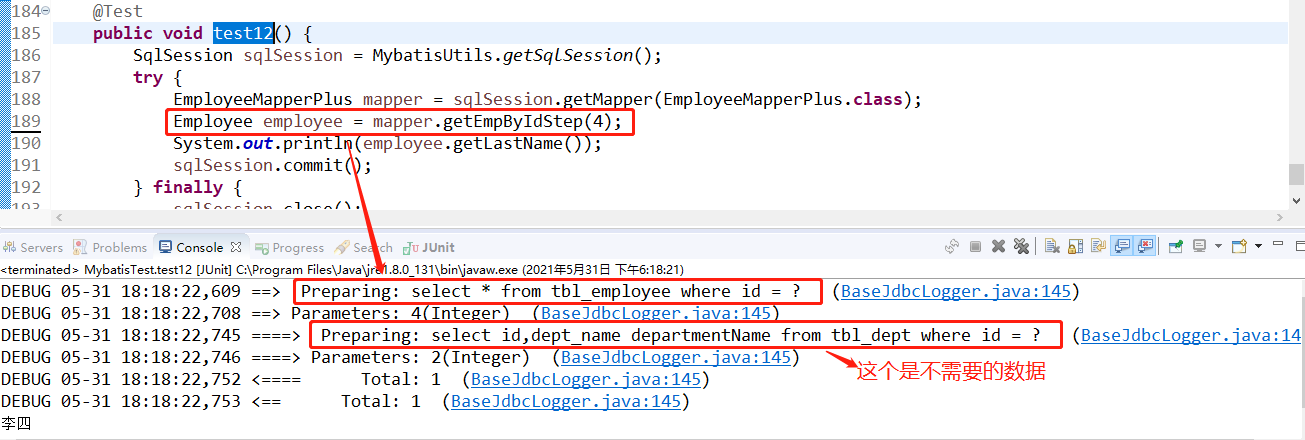
若开启了懒加载
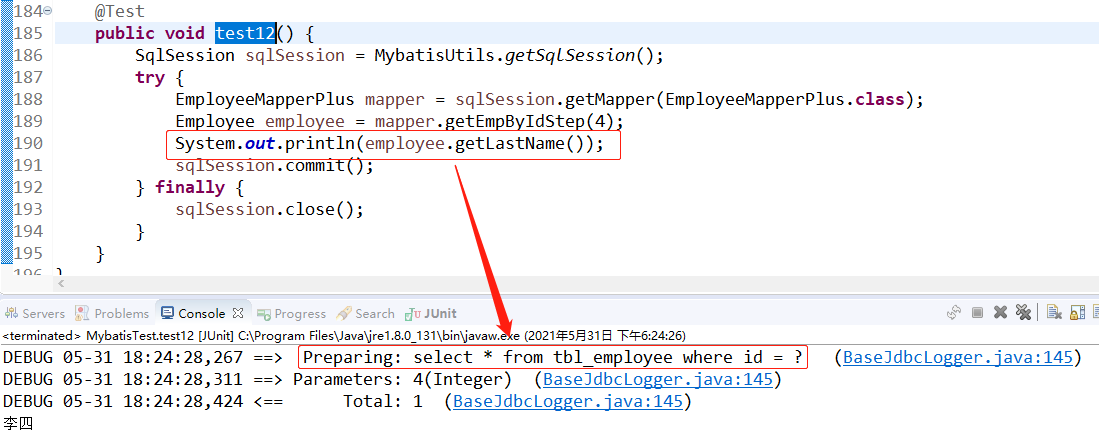
场景二(一对多):
查询Department同时查询部门包含的员工
Department=====Employee
实体类
public class Department {
private Integer id;
private String departmentName;
private List<Employee> emps;
}
public class Employee {
private Integer id;
private String lastName;
private String gender;
private String email;
private Department dept;
}
嵌套结果集的方式
Mapper.xml
集合 -----》collection
ofType:指定集合里面元素的类型
<!--嵌套结果集的方式,使用collection标签定义关联的集合类型的属性封装规则 -->
<resultMap type="com.atguigu.mybatis.bean.Department" id="MyDept">
<id column="did" property="id"/>
<result column="dept_name" property="departmentName"/>
<!--
collection定义关联集合类型的属性的封装规则
ofType:指定集合里面元素的类型
-->
<collection property="emps" ofType="com.atguigu.mybatis.bean.Employee">
<!-- 定义这个集合中元素的封装规则 -->
<id column="eid" property="id"/>
<result column="last_name" property="lastName"/>
<result column="email" property="email"/>
<result column="gender" property="gender"/>
</collection>
</resultMap>
<!-- public Department getDeptByIdPlus(Integer id); -->
<select id="getDeptByIdPlus" resultMap="MyDept">
SELECT d.id did,d.dept_name dept_name,
e.id eid,e.last_name last_name,e.email email,e.gender gender
FROM tbl_dept d
LEFT JOIN tbl_employee e
ON d.id=e.d_id
WHERE d.id=#{id}
</select>
分段查询
<!-- collection:分段查询 -->
<resultMap type="com.atguigu.mybatis.bean.Department" id="MyDeptStep">
<id column="id" property="id"/>
<id column="dept_name" property="departmentName"/>
<collection property="emps"
select="com.atguigu.mybatis.dao.EmployeeMapperPlus.getEmpsByDeptId"
column="id"></collection>
</resultMap>
<!-- public Department getDeptByIdStep(Integer id); -->
<select id="getDeptByIdStep" resultMap="MyDeptStep">
select id,dept_name from tbl_dept where id=#{id}
</select>
select="com.atguigu.mybatis.dao.EmployeeMapperPlus.getEmpsByDeptId"对应的Mapper接口和Mapper.xml
<!-- public List<Employee> getEmpsByDeptId(Integer deptId); -->
<select id="getEmpsByDeptId" resultType="com.atguigu.mybatis.bean.Employee">
select * from tbl_employee where d_id=#{deptId}
</select>
鉴别器 discriminator
<select id="getEmpAndDept1" resultMap="MyEmpDis">
SELECT e.id id, e.last_name
last_name, e.gender gender, e.email email,e.d_id d_id,d.id did
,d.dept_name dept_name
FROM tbl_employee e,tbl_dept d
WHERE e.d_id =
d.id AND e.id = #{id};
</select>
<resultMap type="employee" id="MyEmpDis">
<id column="id" property="id" />
<result column="last_name" property="lastName" />
<result column="gender" property="gender" />
<result column="email" property="email" />
<!--
column:指定判定的列名
javaType:列值对应的java类型
-->
<discriminator javaType="string" column="gender">
<!--女生 resultType:指定封装的结果类型;不能缺少。/resultMap-->
<case value="0" resultType="employee">
<association property="dept" javaType="department">
<id column="did" property="id"/>
<result column="dept_name" property="departmentName"/>
</association>
</case>
<!--男生 ;如果是男生,把last_name这一列的值赋值给email; -->
<case value="1" resultType="employee">
<result column="last_name" property="email" />
</case>
</discriminator>
</resultMap>
练习2(@Param):根据 密码 和 名字 查询用户
方法一:直接在方法中传递参数
1、在接口方法的参数前加 @Param属性
2、Sql语句编写的时候,直接取@Param中设置的值即可,不需要单独设置参数类型
注意:@Param和@RequestParam是什么关系呢?其实它们没有关系,就跟Java和JavaScript,雷锋和雷锋塔一样,拥有相似的外表,其实作用是不一样的,@Param是地处Dao层,是为了传递多个参数,解决的是可读性和直观性;而@RequestParam是位列Controller层,作用是为获取前端参数,解决的是前后端参数不一致的问题。所以它们没有关系!
//通过密码和名字查询用户
User selectUserByNP(@Param("username") String username,@Param("pwd") String pwd);
/*
<select id="selectUserByNP" resultType="com.kuang.pojo.User">
select * from user where name = #{username} and pwd = #{pwd}
</select>
*/
方法二:使用万能的Map
1、在接口方法中,如果传递的参数是实体类对象,在mapper.xml中需要写完该对象的全部字段,如果在接口方法中传递的是map类型的对象,在mapper.xml中就不需要写完map类型对象的全部字段
User selectUserByNP2(Map<String,Object> map);
2、编写sql语句的时候,需要传递参数类型,参数类型为map
<select id="selectUserByNP2" parameterType="map" resultType="com.kuang.pojo.User">
select * from user where name = #{username} and pwd = #{pwd}
</select>
3、在使用方法的时候,Map的 key 为 sql中取的值即可,没有顺序要求!
Map<String, Object> map = new HashMap<String, Object>();
map.put("username","小明");
map.put("pwd","123456");
User user = mapper.selectUserByNP2(map);
insert
我们一般使用insert标签进行插入操作,它的配置和select标签差不多!
需求:给数据库增加一个用户
1、在UserMapper接口中添加对应的方法
//添加一个用户
int addUser(User user);
2、在UserMapper.xml中添加insert语句
<insert id="addUser" parameterType="com.kuang.pojo.User">
insert into user (id,name,pwd) values (#{id},#{name},#{pwd})
</insert>
3、测试
@Test
public void testAddUser() {
SqlSession session = MybatisUtils.getSession();
UserMapper mapper = session.getMapper(UserMapper.class);
User user = new User(5,"王五","zxcvbn");
int i = mapper.addUser(user);
System.out.println(i);
session.commit(); //提交事务,重点!不写的话不会提交到数据库
session.close();
}
注意点:增、删、改操作需要提交事务!
补充(看不懂可以跳过):
数据源不同,插入的方法步骤也不太一样,比如mysql 数据源和oracle数据源,MySQL可以获取数据库中自增主键值,但Oracle不支持
mysql数据源:
- mybatis-config.xml,分别配置了mysql和oracle数据源,
标签配置默认环境
<properties resource="dbconfig.properties"></properties>
<!--
db.config.properties配置文件内容如下:
jdbc.driver=com.mysql.jdbc.Driver
jdbc.url=jdbc:mysql://localhost:3306/mybatis
jdbc.username=root
jdbc.password=123456
orcl.driver=oracle.jdbc.OracleDriver
orcl.url=jdbc:oracle:thin:@localhost:1521:orcl
orcl.username=scott
orcl.password=123456
-->
<!--
4、environments:环境们,mybatis可以配置多种环境 ,default指定使用某种环境。可以达到快速切换环境。
environment:配置一个具体的环境信息;必须有两个标签;id代表当前环境的唯一标识
transactionManager:事务管理器;
type:事务管理器的类型;JDBC(JdbcTransactionFactory)|MANAGED(ManagedTransactionFactory)
自定义事务管理器:实现TransactionFactory接口.type指定为全类名
dataSource:数据源;
type:数据源类型;UNPOOLED(UnpooledDataSourceFactory)
|POOLED(PooledDataSourceFactory)
|JNDI(JndiDataSourceFactory)
自定义数据源:实现DataSourceFactory接口,type是全类名
-->
<!-- 默认使用 dev_mysql-->
<environments default="dev_mysql">
<environment id="dev_mysql">
<transactionManager type="JDBC"></transactionManager>
<dataSource type="POOLED">
<property name="driver" value="${jdbc.driver}" />
<property name="url" value="${jdbc.url}" />
<property name="username" value="${jdbc.username}" />
<property name="password" value="${jdbc.password}" />
</dataSource>
</environment>
<environment id="dev_oracle">
<transactionManager type="JDBC" />
<dataSource type="POOLED">
<property name="driver" value="${orcl.driver}" />
<property name="url" value="${orcl.url}" />
<property name="username" value="${orcl.username}" />
<property name="password" value="${orcl.password}" />
</dataSource>
</environment>
</environments>
<!-- 5、databaseIdProvider:支持多数据库厂商的;
type="DB_VENDOR":VendorDatabaseIdProvider
作用就是得到数据库厂商的标识(驱动getDatabaseProductName()),mybatis就能根据数据库厂商标识来执行不同的sql;
MySQL,Oracle,SQL Server,xxxx
-->
<databaseIdProvider type="DB_VENDOR">
<!-- 为不同的数据库厂商起别名 -->
<property name="MySQL" value="mysql"/>
<property name="Oracle" value="oracle"/>
<property name="SQL Server" value="sqlserver"/>
</databaseIdProvider>
2.Mapper.xml
<!-- public void addEmp(Employee employee); -->
<!-- parameterType:参数类型,可以省略,
获取自增主键的值:
mysql支持自增主键,自增主键值的获取,mybatis也是利用statement.getGenreatedKeys();
useGeneratedKeys="true";使用自增主键获取主键值策略
keyProperty;指定对应的主键属性,也就是mybatis获取到主键值以后,将这个值封装给javaBean的哪个属性
-->
<insert id="addEmp" parameterType="com.atguigu.mybatis.bean.Employee"
useGeneratedKeys="true" keyProperty="id" databaseId="mysql">
insert into tbl_employee(last_name,email,gender)
values(#{lastName},#{email},#{gender})
</insert>
3.Mapper接口
public void addEmp(Employee employee)
4.测试
@Test
public void test03() throws IOException{
SqlSessionFactory sqlSessionFactory = getSqlSessionFactory();
//1、获取到的SqlSession不会自动提交数据
SqlSession openSession = sqlSessionFactory.openSession();
try{
EmployeeMapper mapper = openSession.getMapper(EmployeeMapper.class);
//测试添加
Employee employee = new Employee(null, "jerry4",null, "1");
mapper.addEmp(employee);
System.out.println(employee.getId());
openSession.commit();
}finally{
openSession.close();
}
}
5.测试结果
Employee employee = new Employee(null, "jerry4",null, "1");
System.out.println(employee.getId());
根据上面俩行代码,按照一般的分析,肯定会输出null值,但是结果能输出具体的数据,而并非null,说明Mapper.xml进行sql语句插入时得到了id值,并把employee 对象的id值传回给employee对象
Oracle数据源:
1.修改mybatis-config.xml
<environments default="dev_oracle">
<environment id="dev_oracle">
<transactionManager type="JDBC" />
<dataSource type="POOLED">
<property name="driver" value="${orcl.driver}" />
<property name="url" value="${orcl.url}" />
<property name="username" value="${orcl.username}" />
<property name="password" value="${orcl.password}" />
</dataSource>
</environment>
</environments>
2.Mapper.xml映射文件
<!--
获取非自增主键的值:
Oracle不支持自增;Oracle使用序列来模拟自增;
每次插入的数据的主键是从序列中拿到的值;如何获取到这个值;
-->
<insert id="addEmp" databaseId="oracle">
<!--
keyProperty:查出的主键值封装给javaBean的哪个属性
order="BEFORE":当前sql在插入sql之前运行
AFTER:当前sql在插入sql之后运行
resultType:查出的数据的返回值类型
BEFORE运行顺序:
先运行selectKey查询id的sql;查出id值封装给javaBean的id属性
在运行插入的sql;就可以取出id属性对应的值
AFTER运行顺序:
先运行插入的sql(从序列中取出新值作为id);
再运行selectKey查询id的sql;
-->
<selectKey keyProperty="id" order="BEFORE" resultType="Integer">
<!-- 编写查询主键的sql语句 -->
<!-- BEFORE-->
select EMPLOYEES_SEQ.nextval from dual
<!-- AFTER:
select EMPLOYEES_SEQ.currval from dual -->
</selectKey>
<!-- 插入时的主键是从序列中拿到的 -->
<!-- BEFORE:-->
insert into employees(EMPLOYEE_ID,LAST_NAME,EMAIL)
values(#{id},#{lastName},#{email<!-- ,jdbcType=NULL -->})
<!-- AFTER:
insert into employees(EMPLOYEE_ID,LAST_NAME,EMAIL)
values(employees_seq.nextval,#{lastName},#{email}) -->
</insert>
3.Mapper接口
public void addEmp(Employee employee)
4.测试
@Test
public void test03() throws IOException{
SqlSessionFactory sqlSessionFactory = getSqlSessionFactory();
//1、获取到的SqlSession不会自动提交数据
SqlSession openSession = sqlSessionFactory.openSession();
try{
EmployeeMapper mapper = openSession.getMapper(EmployeeMapper.class);
//测试添加
Employee employee = new Employee(null, "jerry4",null, "1");
mapper.addEmp(employee);
System.out.println(employee.getId());
openSession.commit();
}finally{
openSession.close();
}
}
5.测试结果
System.out.println(employee.getId()); //3
update
我们一般使用update标签进行更新操作,它的配置和select标签差不多!
需求:修改用户的信息
1、同理,编写接口方法
//修改一个用户
int updateUser(User user);
2、编写对应的配置文件SQL
<update id="updateUser" parameterType="com.kuang.pojo.User">
update user set name=#{name},pwd=#{pwd} where id = #{id}
</update>
3、测试
@Test
public void testUpdateUser() {
SqlSession session = MybatisUtils.getSession();
UserMapper mapper = session.getMapper(UserMapper.class);
User user = mapper.selectUserById(1);
user.setPwd("asdfgh");
int i = mapper.updateUser(user);
System.out.println(i);
session.commit(); //提交事务,重点!不写的话不会提交到数据库
session.close();
}
delete
我们一般使用delete标签进行删除操作,它的配置和select标签差不多!
需求:根据id删除一个用户
1、同理,编写接口方法
//根据id删除用户
int deleteUser(int id);
2、编写对应的配置文件SQL
<delete id="deleteUser" parameterType="int">
delete from user where id = #{id}
</delete>
3、测试
@Test
public void testDeleteUser() {
SqlSession session = MybatisUtils.getSession();
UserMapper mapper = session.getMapper(UserMapper.class);
int i = mapper.deleteUser(5);
System.out.println(i);
session.commit(); //提交事务,重点!不写的话不会提交到数据库
session.close();
}
小结:
- 所有的增删改操作都需要提交事务!
- 接口所有的普通参数,尽量都写上@Param参数,尤其是多个参数时,必须写上!
- 有时候根据业务的需求,可以考虑使用map传递参数!
- 为了规范操作,在SQL的配置文件中,我们尽量将Parameter参数和resultType都写上
模糊查询like语句
第1种(推荐):在Java代码中添加sql通配符。
string str = “%smi%”;
list<name> names = mapper.selectlike(str);
<select id=”selectlike”>
select * from foo where bar like #{str}
</select>
第2种(不推荐):在sql语句中拼接通配符,会引起sql注入
string str = “smi”;
list<name> names = mapper.selectlike(str);
<select id=”selectlike”>
select * from foo where bar like "%"#{str}"%"
</select>
配置解析
核心配置文件
-
mybatis-config.xml 系统核心配置文件
-
一下这个配置文件看起来有点乱,看不懂可以跳过,因为还会细分讲解
<?xml version="1.0" encoding="UTF-8" ?> <!DOCTYPE configuration PUBLIC "-//mybatis.org//DTD Config 3.0//EN" "http://mybatis.org/dtd/mybatis-3-config.dtd"> <configuration> <!-- 1、mybatis可以使用properties来引入外部properties配置文件的内容; resource:引入类路径下的资源 url:引入网络路径或者磁盘路径下的资源 --> <properties resource="dbconfig.properties"></properties> <!-- 2、settings包含很多重要的设置项 setting:用来设置每一个设置项 name:设置项名 value:设置项取值 --> <!-- 下划线驼峰自动转换,例如数据库表中某一字段last-name,javaBean类中某一属性lastName,则在映射的时候字段名last-name会自动转换为属性名lastName --> <settings> <setting name="mapUnderscoreToCamelCase" value="true"/> </settings> <!-- 3、typeAliases:别名处理器:可以为我们的java类型起别名 别名不区分大小写 --> <typeAliases> <!-- 1、typeAlias:为某个java类型起别名 type:指定要起别名的类型全类名;默认别名就是类名小写;employee alias:指定新的别名 --> <!-- <typeAlias type="com.atguigu.mybatis.bean.Employee" alias="emp"/> --> <!-- 2、package:为某个包下的所有类批量起别名 name:指定包名(为当前包以及下面所有的后代包的每一个类都起一个默认别名(类名小写),) --> <package name="com.atguigu.mybatis.bean"/> <!-- 3、批量起别名的情况下,使用@Alias注解为某个类型指定新的别名 --> <!--例如: @Alias("emp") public class Employee {} --> </typeAliases> <!-- 4、environments:环境们,mybatis可以配置多种环境 ,default指定使用某种环境。可以达到快速切换环境。 environment:配置一个具体的环境信息;必须有两个标签;id代表当前环境的唯一标识 transactionManager:事务管理器; type:事务管理器的类型;JDBC(JdbcTransactionFactory)|MANAGED(ManagedTransactionFactory) 自定义事务管理器:实现TransactionFactory接口.type指定为全类名 dataSource:数据源; type:数据源类型;UNPOOLED(UnpooledDataSourceFactory) |POOLED(PooledDataSourceFactory) |JNDI(JndiDataSourceFactory) 自定义数据源:实现DataSourceFactory接口,type是全类名 --> <environments default="dev_mysql"> <environment id="dev_mysql"> <transactionManager type="JDBC"></transactionManager> <dataSource type="POOLED"> <property name="driver" value="${jdbc.driver}" /> <property name="url" value="${jdbc.url}" /> <property name="username" value="${jdbc.username}" /> <property name="password" value="${jdbc.password}" /> </dataSource> </environment> <environment id="dev_oracle"> <transactionManager type="JDBC" /> <dataSource type="POOLED"> <property name="driver" value="${orcl.driver}" /> <property name="url" value="${orcl.url}" /> <property name="username" value="${orcl.username}" /> <property name="password" value="${orcl.password}" /> </dataSource> </environment> </environments> <!-- 5、databaseIdProvider:支持多数据库厂商的; type="DB_VENDOR":VendorDatabaseIdProvider 作用就是得到数据库厂商的标识(驱动getDatabaseProductName()),mybatis就能根据数据库厂商标识来执行不同的sql; MySQL,Oracle,SQL Server,xxxx --> <databaseIdProvider type="DB_VENDOR"> <!-- 为不同的数据库厂商起别名 --> <property name="MySQL" value="mysql"/> <property name="Oracle" value="oracle"/> <property name="SQL Server" value="sqlserver"/> </databaseIdProvider> <!-- 将我们写好的sql映射文件(EmployeeMapper.xml)一定要注册到全局配置文件(mybatis-config.xml)中 --> <!-- 6、mappers:将sql映射注册到全局配置中 --> <mappers> <!-- mapper:注册一个sql映射 注册配置文件 1.resource:引用类路径下的sql映射文件 mybatis/mapper/EmployeeMapper.xml url:引用网路路径或者磁盘路径下的sql映射文件 file:///var/mappers/AuthorMapper.xml 注册接口 2.class:引用(注册)接口, 1)、有sql映射文件,映射文件名必须和接口同名,并且放在与接口同一目录下; 2)、(过时)没有sql映射文件,所有的sql都是利用注解写在接口上; 推荐: 比较重要的,复杂的Dao接口我们来写sql映射文件 不重要,简单的Dao接口为了开发快速可以使用注解; 3.批量注册:package引用,有sql映射文件,映射文件名必须和接口同名,映射文件可以放在与接口同一目录下,也可以放在静态resources包,但是要保证映射文件所在的目录要和接口的目录结构一样(映射文件的包路径==接口的包路径)
-->
<!--没有sql映射文件,所有的sql都是利用注解写在接口上;-->
<!-- <mapper class="com.atguigu.mybatis.dao.EmployeeMapperAnnotation"/> -->
<!-- 批量注册: -->
<package name="com.atguigu.mybatis.dao"/>
</mappers>
dbconfig.properties配置文件
jdbc.driver=com.mysql.jdbc.Driver
jdbc.url=jdbc:mysql://localhost:3306/mybatis
jdbc.username=root
jdbc.password=123456
orcl.driver=oracle.jdbc.OracleDriver
orcl.url=jdbc:oracle:thin:@localhost:1521:orcl
orcl.username=scott
orcl.password=123456
mybatis参数配置
单个参数:mybatis不会做特殊处理,
#{参数名/任意名}:取出参数值。
多个参数:mybatis会做特殊处理。
多个参数会被封装成 一个map,
key:param1...paramN,或者参数的索引也可以
value:传入的参数值
#{}就是从map中获取指定的key的值;
异常:
org.apache.ibatis.binding.BindingException:
Parameter 'id' not found.
Available parameters are [1, 0, param1, param2]
操作:
方法:public Employee getEmpByIdAndLastName(Integer id,String lastName);
取值:#{id},#{lastName}
【命名参数】:明确指定封装参数时map的key;@Param("id")
多个参数会被封装成 一个map,
key:使用@Param注解指定的值
value:参数值
#{指定的key}取出对应的参数值
POJO:
如果多个参数正好是我们业务逻辑的数据模型,我们就可以直接传入pojo;
#{属性名}:取出传入的pojo的属性值
Map:
如果多个参数不是业务模型中的数据,没有对应的pojo,不经常使用,为了方便,我们也可以传入map
#{key}:取出map中对应的值
TO:
如果多个参数不是业务模型中的数据,但是经常要使用,推荐来编写一个TO(Transfer Object)数据传输对象
Page{
int index;
int size;
}
========================思考================================
public Employee getEmp(@Param("id")Integer id,String lastName);
取值:id==>#{id/param1} lastName==>#{param2}
public Employee getEmp(Integer id,@Param("e")Employee emp);
取值:id==>#{param1} lastName===>#{param2.lastName/e.lastName}
##特别注意:如果是Collection(List、Set)类型或者是数组,
也会特殊处理。也是把传入的list或者数组封装在map中。
key:Collection(collection),如果是List还可以使用这个key(list)
数组(array)
public Employee getEmpById(List<Integer> ids);
取值:取出第一个id的值: #{list[0]}
========================结合源码,mybatis怎么处理参数==========================
总结:参数多时会封装map,为了不混乱,我们可以使用@Param来指定封装时使用的key;
#{key}就可以取出map中的值;
(@Param("id")Integer id,@Param("lastName")String lastName);
ParamNameResolver解析参数封装map的;
//1、names:{0=id, 1=lastName};构造器的时候就确定好了
确定流程:
1.获取每个标了param注解的参数的@Param的值:id,lastName; 赋值给name;
2.每次解析一个参数给map中保存信息:(key:参数索引,value:name的值)
name的值:
标注了param注解:注解的值
没有标注:
1.全局配置:useActualParamName(jdk1.8):name=参数名
2.name=map.size();相当于当前元素的索引
{0=id, 1=lastName,2=2}
args【1,"Tom",'hello'】:
public Object getNamedParams(Object[] args) {
final int paramCount = names.size();
//1、参数为null直接返回
if (args == null || paramCount == 0) {
return null;
//2、如果只有一个元素,并且没有Param注解;args[0]:单个参数直接返回
} else if (!hasParamAnnotation && paramCount == 1) {
return args[names.firstKey()];
//3、多个元素或者有Param标注
} else {
final Map<String, Object> param = new ParamMap<Object>();
int i = 0;
//4、遍历names集合;{0=id, 1=lastName,2=2}
for (Map.Entry<Integer, String> entry : names.entrySet()) {
//names集合的value作为key; names集合的key又作为取值的参考args[0]:args【1,"Tom",'hello'】:
//eg:{id=args[0]:1,lastName=args[1]:Tom,2=args[2]}
param.put(entry.getValue(), args[entry.getKey()]);
// add generic param names (param1, param2, ...)param
//额外的将每一个参数也保存到map中,使用新的key:param1...paramN
//效果:有Param注解可以#{指定的key},或者#{param1}
final String genericParamName = GENERIC_NAME_PREFIX + String.valueOf(i + 1);
// ensure not to overwrite parameter named with @Param
if (!names.containsValue(genericParamName)) {
param.put(genericParamName, args[entry.getKey()]);
}
i++;
}
return param;
}
}
}
===========================参数值的获取======================================
#{}:可以获取map中的值或者pojo对象属性的值;
${}:可以获取map中的值或者pojo对象属性的值;
select * from tbl_employee where id=${id} and last_name=#{lastName}
Preparing: select * from tbl_employee where id=2 and last_name=?
区别:
#{}:是以预编译的形式,将参数设置到sql语句中;PreparedStatement;防止sql注入
${}:取出的值直接拼装在sql语句中;会有安全问题;
大多情况下,我们去参数的值都应该去使用#{};
原生jdbc不支持占位符的地方我们就可以使用${}进行取值
比如分表、排序。。。;按照年份分表拆分
select * from ${year}_salary where xxx;
select * from tbl_employee order by ${f_name} ${order}
#{}:更丰富的用法:
规定参数的一些规则:
javaType、 jdbcType、 mode(存储过程)、 numericScale、
resultMap、 typeHandler、 jdbcTypeName、 expression(未来准备支持的功能);
jdbcType通常需要在某种特定的条件下被设置:
在我们数据为null的时候,有些数据库可能不能识别mybatis对null的默认处理。比如Oracle(报错);
JdbcType OTHER:无效的类型;因为mybatis对所有的null都映射的是原生Jdbc的OTHER类型,oracle不能正确处理;
由于全局配置中:jdbcTypeForNull=OTHER;oracle不支持;两种办法
1、#{email,jdbcType=OTHER};
2、jdbcTypeForNull=NULL
<setting name="jdbcTypeForNull" value="NULL"/>
- MyBatis 的配置文件包含了会深深影响 MyBatis 行为的设置和属性信息
- 内容如下:
configuration(配置)
properties(属性)
settings(设置)
typeAliases(类型别名)
typeHandlers(类型处理器)
objectFactory(对象工厂)
plugins(插件)
environments(环境配置)
environment(环境变量)
transactionManager(事务管理器)
dataSource(数据源)
databaseIdProvider(数据库厂商标识)
mappers(映射器)
<!-- 注意元素节点的顺序!顺序不对会报错 -->
properties
<!--
1、mybatis可以使用properties来引入外部properties配置文件的内容;
resource:引入类路径下的资源
url:引入网络路径或者磁盘路径下的资源
-->
<properties resource="db.properties"></properties>
jdbc.driver=com.mysql.jdbc.Driver
jdbc.url=jdbc:mysql://localhost:3306/mybatis
jdbc.username=root
jdbc.password=123456
orcl.driver=oracle.jdbc.OracleDriver
orcl.url=jdbc:oracle:thin:@localhost:1521:orcl
orcl.username=scott
orcl.password=123123
environments元素
environments元素:主要配置和数据库相关的参数
<environments default="development">
<environment id="development">
<transactionManager type="JDBC">
<property name="..." value="..."/>
</transactionManager>
<dataSource type="POOLED">
<property name="driver" value="${driver}"/>
<property name="url" value="${url}"/>
<property name="username" value="${username}"/>
<property name="password" value="${password}"/>
</dataSource>
</environment>
</environments>
-
配置MyBatis的多套运行环境,将SQL映射到多个不同的数据库上,必须指定其中一个为默认运行环境(通过default指定)
-
子元素节点:environment
-
-
dataSource 元素使用标准的 JDBC 数据源接口来配置 JDBC 连接对象的资源。
-
数据源是必须配置的。
-
有三种内建的数据源类型
-
type="[UNPOOLED|POOLED|JNDI]")-
unpooled:这个数据源的实现只是每次被请求时打开和关闭连接。
-
pooled:这种数据源的实现利用“池”的概念将 JDBC 连接对象组织起来 , 这是一种使得并发 Web 应用快速响应请求的流行处理方式。
-
jndi:这个数据源的实现是为了能在如 Spring 或应用服务器这类容器中使用,容器可以集中或在外部配置数据源,然后放置一个 JNDI 上下文的引用。
-
数据源dataSource也有很多第三方的实现,比如dbcp,c3p0,druid等等....
-
详情:点击查看官方文档
-
这两种事务管理器类型都不需要设置任何属性。
-
具体的一套环境,通过设置id进行区别,id保证唯一!
-
子元素节点:transactionManager - [ 事务管理器 ]
<!-- 语法 --> <transactionManager type="[ JDBC | MANAGED ]"/> -
子元素节点:数据源(dataSource)
-
-
mapper元素
- 映射器 : 定义映射SQL语句文件
- 既然 MyBatis 的行为其他元素已经配置完了,我们现在就要定义 SQL 映射语句了。但是首先我们需要告诉 MyBatis 到哪里去找到这些语句。Java 在自动查找这方面没有提供一个很好的方法,所以最佳的方式是告诉 MyBatis 到哪里去找映射文件。你可以使用相对于类路径的资源引用, 或完全限定资源定位符(包括
file:///的 URL),或类名和包名等。映射器是MyBatis中最核心的组件之一,在MyBatis 3之前,只支持xml映射器,即:所有的SQL语句都必须在xml文件中配置。而从MyBatis 3开始,还支持接口映射器,这种映射器方式允许以Java代码的方式注解定义SQL语句,非常简洁。
引入资源方式
-
方式一:
<!-- 使用相对于类路径的资源引用 --> <mappers> <mapper resource="org/mybatis/builder/PostMapper.xml"/> </mappers> -
方式二:
<!-- 使用完全限定资源定位符(URL) --> <mappers> <mapper url="file:///var/mappers/AuthorMapper.xml"/> </mappers> -
方式三(推荐):
<!-- 将包内的映射器接口实现全部注册为映射器 但是需要配置文件名称和接口名称一致,并且位于同一目录下 --> <mappers> <package name="org.mybatis.builder"/> </mappers>
Mapper文件
<?xml version="1.0" encoding="UTF-8" ?>
<!DOCTYPE mapper
PUBLIC "-//mybatis.org//DTD Mapper 3.0//EN"
"http://mybatis.org/dtd/mybatis-3-mapper.dtd">
<mapper namespace="com.kuang.mapper.UserMapper">
</mapper>
-
namespace中文意思:命名空间,作用如下:
-
- namespace的命名必须跟某个接口同名
- 接口中的方法与映射文件中sql语句id应该一一对应
-
- namespace和子元素的id联合保证唯一 , 区别不同的mapper
- 绑定DAO接口
- namespace命名规则 : 包名+类名
MyBatis 的真正强大在于它的映射语句,这是它的魔力所在。由于它的异常强大,映射器的 XML 文件就显得相对简单。如果拿它跟具有相同功能的 JDBC 代码进行对比,你会立即发现省掉了将近 95% 的代码。MyBatis 为聚焦于 SQL 而构建,以尽可能地为你减少麻烦。
properties优化
数据库这些属性都是可外部配置且可动态替换的,既可以在典型的 Java 属性文件中配置,亦可通过 properties 元素的子元素来传递。具体的官方文档
我们来优化我们的配置文件
第一步 ; 在资源目录下新建一个db.properties
driver=com.mysql.jdbc.Driver
url=jdbc:mysql://localhost:3306/mybatis?useSSL=true&useUnicode=true&characterEncoding=utf8
username=root
password=123123
第二步 : 将文件导入properties 配置文件
<configuration>
<!--导入properties文件-->
<properties resource="db.properties"/>
<environments default="development">
<environment id="development">
<transactionManager type="JDBC"/>
<dataSource type="POOLED">
<property name="driver" value="${driver}"/>
<property name="url" value="${url}"/>
<property name="username" value="${username}"/>
<property name="password" value="${password}"/>
</dataSource>
</environment>
</environments>
<mappers>
<mapper resource="mapper/UserMapper.xml"/>
</mappers>
</configuration>
typeAliases优化
类型别名是为 Java 类型设置一个短的名字。它只和 XML 配置有关,存在的意义仅在于用来减少类完全限定名的冗余。
方式一:
<!--配置别名,注意顺序-->
<typeAliases>
<typeAlias type="com.kuang.pojo.User" alias="User"/>
</typeAliases>
方式二:
指定一个包名,MyBatis 会在包名下面搜索需要的 Java Bean
<typeAliases>
<package name="com.kuang.pojo"/>
</typeAliases>
每一个在包 com.kuang.pojo 中的 Java Bean,在没有注解的情况下,会使用 Bean 的首字母小写的非限定类名来作为它的别名。例如:com.pojo.Employee ---->employee
若有注解,则别名为其注解值。见下面的例子:
@Alias("user")
public class User {
...
}
其他配置
-
设置(settings)相关 => 查看帮助文档
-
- 懒加载
- 日志实现
- 缓存开启关闭
-
一个配置完整的 settings 元素的示例如下:
<settings> <setting name="cacheEnabled" value="true"/> <setting name="lazyLoadingEnabled" value="true"/> <setting name="multipleResultSetsEnabled" value="true"/> <setting name="useColumnLabel" value="true"/> <setting name="useGeneratedKeys" value="false"/> <setting name="autoMappingBehavior" value="PARTIAL"/> <setting name="autoMappingUnknownColumnBehavior" value="WARNING"/> <setting name="defaultExecutorType" value="SIMPLE"/> <setting name="defaultStatementTimeout" value="25"/> <setting name="defaultFetchSize" value="100"/> <setting name="safeRowBoundsEnabled" value="false"/> <setting name="mapUnderscoreToCamelCase" value="false"/> <setting name="localCacheScope" value="SESSION"/> <setting name="jdbcTypeForNull" value="OTHER"/> <setting name="lazyLoadTriggerMethods"value="equals,clone,hashCode,toString"/> </settings>
类型处理器
- 无论是 MyBatis 在预处理语句(PreparedStatement)中设置一个参数时,还是从结果集中取出一个值时, 都会用类型处理器将获取的值以合适的方式转换成 Java 类型。
- 你可以重写类型处理器或创建你自己的类型处理器来处理不支持的或非标准的类型。【了解即可】
对象工厂
-
MyBatis 每次创建结果对象的新实例时,它都会使用一个对象工厂(ObjectFactory)实例来完成。
-
默认的对象工厂需要做的仅仅是实例化目标类,要么通过默认构造方法,要么在参数映射存在的时候通过有参构造方法来实例化。
-
如果想覆盖对象工厂的默认行为,则可以通过创建自己的对象工厂来实现。【了解即可】
作用域(Scope)和生命周期
理解我们目前已经讨论过的不同作用域和生命周期类是至关重要的,因为错误的使用会导致非常严重的并发问题。
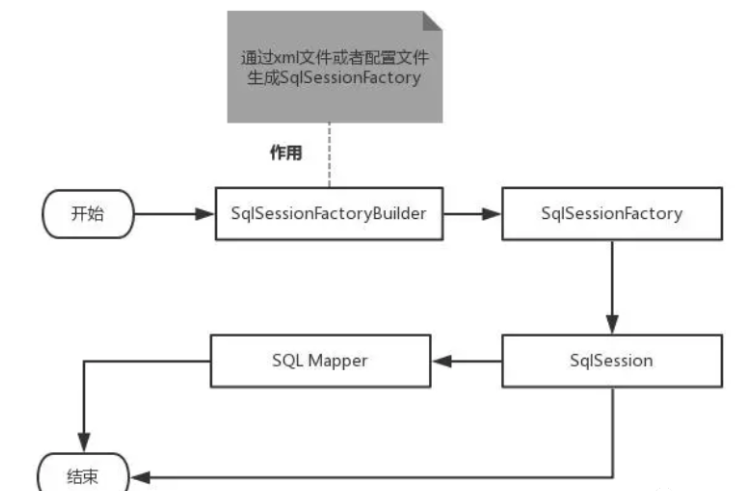
作用域理解
- SqlSessionFactoryBuilder 的作用在于创建 SqlSessionFactory,创建成功后,SqlSessionFactoryBuilder 就失去了作用,所以它只能存在于创建 SqlSessionFactory 的方法中,而不要让其长期存在。因此 SqlSessionFactoryBuilder 实例的最佳作用域是方法作用域(也就是局部方法变量)。
- SqlSessionFactory 可以被认为是一个数据库连接池,它的作用是创建 SqlSession 接口对象。因为 MyBatis 的本质就是 Java 对数据库的操作,所以 SqlSessionFactory 的生命周期存在于整个 MyBatis 的应用之中,所以一旦创建了 SqlSessionFactory,就要长期保存它,直至不再使用 MyBatis 应用,所以可以认为 SqlSessionFactory 的生命周期就等同于 MyBatis 的应用周期。
- 由于 SqlSessionFactory 是一个对数据库的连接池,所以它占据着数据库的连接资源。如果创建多个 SqlSessionFactory,那么就存在多个数据库连接池,这样不利于对数据库资源的控制,也会导致数据库连接资源被消耗光,出现系统宕机等情况,所以尽量避免发生这样的情况。
- 因此在一般的应用中我们往往希望 SqlSessionFactory 作为一个单例,让它在应用中被共享。所以说 SqlSessionFactory 的最佳作用域是应用作用域。
- 如果说 SqlSessionFactory 相当于数据库连接池,那么 SqlSession 就相当于一个数据库连接(Connection 对象),你可以在一个事务里面执行多条 SQL,然后通过它的 commit、rollback 等方法,提交或者回滚事务。所以它应该存活在一个业务请求中,处理完整个请求后,应该关闭这条连接,让它归还给 SqlSessionFactory,否则数据库资源就很快被耗费精光,系统就会瘫痪,所以用 try...catch...finally... 语句来保证其正确关闭。
- 所以 SqlSession 的最佳的作用域是请求或方法作用域。
加深理解:SqlSessionFactoryBuilder造车工厂,SqlSessionFactory租赁公司,SqlSession==租车顾客; 造车工厂(SqlSessionFactoryBuilder)造完车给租赁公司后倒闭消失了,租赁公司(SqlSessionFactory)营业得很好,全世界都存在(全局变量),租车顾客(SqlSession)用完车时需要归还(SQLSession需要关闭)
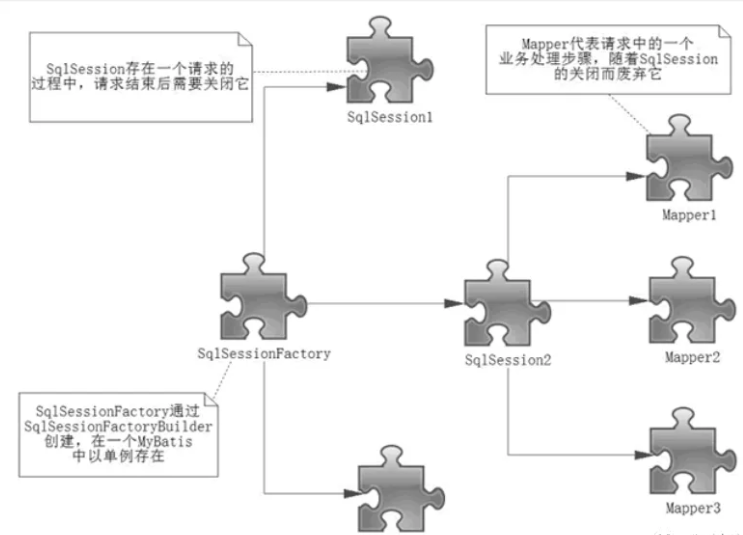
ResultMap及分页
问题:数据库的字段名和javaBea类的字段名不一样
1.查看数据库字段名
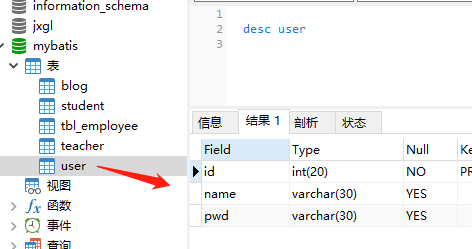
2.查看Java中的实体类设计
public class User {
private int id; //id
private String name; //姓名
private String password; //密码和数据库不一样!
//构造
//set/get
//toString()
}
3.接口的设计
//根据id查询用户
User selectUserById(int id);
4、mapper映射文件
<select id="selectUserById" resultType="user">
select * from user where id = #{id}
</select>
5、测试
@Test
public void testSelectUserById() {
SqlSession session = MybatisUtils.getSession(); //获取SqlSession连接
UserMapper mapper = session.getMapper(UserMapper.class);
User user = mapper.selectUserById(1);
System.out.println(user);
session.close();
}
6.结果
User{id=1, name='狂神', password='null'}
7.分析:
-
select * from user where id = #{id} 可以看做
select id,name,pwd from user where id = #
-
mybatis会根据这些查询的列名(会将列名转化为小写,数据库不区分大小写) , 去对应的实体类中查找相应列名的set方法设值 , 由于找不到setPwd() , 所以password返回null ; 【自动映射】
解决方案一:
为列名指定别名 , 别名和java实体类的属性名一致 .
<select id="selectUserById" resultType="User">
select id , name , pwd as password from user where id = #{id}
</select>
方案二:使用结果集映射->ResultMap 【推荐】
<resultMap id="UserMap" type="User">
<!-- id为主键 -->
<id column="id" property="id"/>
<!-- column是数据库表的列名 , property是对应实体类的属性名 -->
<result column="name" property="name"/>
<result column="pwd" property="password"/>
</resultMap>
<select id="selectUserById" resultMap="UserMap">
select id , name , pwd from user where id = #{id}
</select>
ResultMap
自动映射
- ResultMap 元素是 MyBatis 中最重要最强大的元素。它可以让你从 90% 的 JDBC ResultSet 数据提取代码中解放出来。
- 实际上,在为一些比如连接的复杂语句编写映射代码的时候,一份 ResultMap 能够代替实现同等功能的长达数千行的代码。
- ResultMap 的设计思想是,对于简单的语句根本不需要配置显式的结果映射,而对于复杂一点的语句只需要描述它们的关系就行了。
你已经见过简单映射语句的示例了,但并没有显式指定 ResultMap 。比如:
<select id="selectUserById" resultType="map">
select id , name , pwd
from user
where id = #{id}
</select>
上述语句只是简单地将所有的列映射到 HashMap的键上,这由 resultType属性指定。虽然在大部分情况下都够用,但是 HashMap 不是一个很好的模型。你的程序更可能会使用 JavaBean 或 POJO(Plain Old Java Objects,普通老式 Java 对象)作为模型。
ResultMap 最优秀的地方在于,虽然你已经对它相当了解了,但是根本就不需要显式地用到他们。
手动映射(推荐)
1、返回值类型为resultMap
<select id="selectUserById" resultMap="UserMap">
select id , name , pwd from user where id = #{id}
</select>
2、编写resultMap,实现手动映射!
<resultMap id="UserMap" type="User">
<!-- id为主键 -->
<id column="id" property="id"/>
<!-- column是数据库表的列名 , property是对应实体类的属性名 -->
<result column="name" property="name"/>
<result column="pwd" property="password"/>
</resultMap>
分页的几种方式
日志工厂
思考:我们在测试SQL的时候,要是能够在控制台输出 SQL 的话,是不是就能够有更快的排错效率?
如果一个 数据库相关的操作出现了问题,我们可以根据输出的SQL语句快速排查问题。
对于以往的开发过程,我们会经常使用到debug模式来调节,跟踪我们的代码执行过程。但是现在使用Mybatis是基于接口,配置文件的源代码执行过程。因此,我们必须选择日志工具来作为我们开发,调节程序的工具。
Mybatis内置的日志工厂提供日志功能,具体的日志实现有以下几种工具:
- SLF4J
- Apache Commons Logging
- Log4j 2
- Log4j
- JDK loggin
- STDOUT_LOGGING
具体选择哪个日志实现工具由MyBatis的内置日志工厂确定。它会使用最先找到的(按上文列举的顺序查找)。如果一个都未找到,日志功能就会被禁用。
标准日志实现
指定 MyBatis 应该使用哪个日志记录实现。如果此设置不存在,则会自动发现日志记录实现。
以下配置是开启默认的日志实现工具
<settings>
<setting name="logImpl" value="STDOUT_LOGGING"/>
</settings>
测试,可以看到控制台有大量的输出!我们可以通过这些输出来判断程序到底哪里出了Bug
Log4j
- Log4j是Apache的一个开源项目
- 通过使用Log4j,我们可以控制日志信息输送的目的地:控制台,文本,GUI组件....
- 我们也可以控制每一条日志的输出格式;
- 通过定义每一条日志信息的级别,我们能够更加细致地控制日志的生成过程。最令人感兴趣的就是,这些可以通过一个配置文件来灵活地进行配置,而不需要修改应用的代码。
使用步骤:
1、导入log4j的包
<dependency>
<groupId>log4j</groupId>
<artifactId>log4j</artifactId>
<version>1.2.17</version>
</dependency>
2、配置文件编写(log4j.properties)
#将等级为DEBUG的日志信息输出到console和file这两个目的地,console和file的定义在下面的代码
log4j.rootLogger=DEBUG,console,file
#控制台输出的相关设置
log4j.appender.console = org.apache.log4j.ConsoleAppender
log4j.appender.console.Target = System.out
log4j.appender.console.Threshold=DEBUG
log4j.appender.console.layout = org.apache.log4j.PatternLayout
log4j.appender.console.layout.ConversionPattern=[%c]-%m%n
#文件输出的相关设置
log4j.appender.file = org.apache.log4j.RollingFileAppender
log4j.appender.file.File=./log/kuang.log
log4j.appender.file.MaxFileSize=10mb
log4j.appender.file.Threshold=DEBUG
log4j.appender.file.layout=org.apache.log4j.PatternLayout
log4j.appender.file.layout.ConversionPattern=[%p][%d{yy-MM-dd}][%c]%m%n
#日志输出级别
log4j.logger.org.mybatis=DEBUG
log4j.logger.java.sql=DEBUG
log4j.logger.java.sql.Statement=DEBUG
log4j.logger.java.sql.ResultSet=DEBUG
log4j.logger.java.sql.PreparedStatement=DEBUG
3、setting设置日志实现
<settings>
<setting name="logImpl" value="LOG4J"/>
</settings>
4、在程序中使用Log4j进行输出!
//注意导包:org.apache.log4j.Logger
static Logger logger = Logger.getLogger(MyTest.class);
@Test
public void selectUser() {
logger.info("info:进入selectUser方法");
logger.debug("debug:进入selectUser方法");
logger.error("error: 进入selectUser方法");
SqlSession session = MybatisUtils.getSession();
UserMapper mapper = session.getMapper(UserMapper.class);
List<User> users = mapper.selectUser();
for (User user: users){
System.out.println(user);
}
session.close();
}
5、测试,看控制台输出!
- 使用Log4j 输出日志
- 可以看到还生成了一个日志的文件 【需要修改file的日志级别】
Limit分页
在学习mybatis等持久层框架的时候,会经常对数据进行增删改查操作,使用最多的是对数据库进行查询操作,如果查询大量数据的时候,我们往往使用分页进行查询,也就是每次处理小部分数据,这样对数据库压力就在可控范围内。
使用Limit实现分页
注意:mysql索引一般从1开始(limit除外,limit从索引1开始)
#语法
SELECT * FROM table LIMIT stratIndex,pageSize
SELECT * FROM table LIMIT 5,10; // 检索记录行 6-15
#为了检索从某一个偏移量到记录集的结束所有的记录行,可以指定第二个参数为 -1:
SELECT * FROM table LIMIT 95,-1; // 检索记录行 96-last.
#如果只给定一个参数,它表示返回最大的记录行数目:
SELECT * FROM table LIMIT 5; //检索前 5 个记录行
#换句话说,LIMIT n 等价于 LIMIT 0,n。
步骤:
1、修改Mapper文件
<select id="selectUser" parameterType="map" resultType="user">
select * from user limit #{startIndex},#{pageSize}
</select>
2、Mapper接口,参数为map
//选择全部用户实现分页
List<User> selectUser(Map<String,Integer> map);
3、在测试类中传入参数测试
- 分页公式:起始位置 = (当前页面 - 1 ) * 页面大小
//分页查询 , 两个参数startIndex , pageSize
@Test
public void testSelectUser() {
SqlSession session = MybatisUtils.getSession();
UserMapper mapper = session.getMapper(UserMapper.class);
int currentPage = 1; //第几页
int pageSize = 2; //每页显示几个
Map<String,Integer> map = new HashMap<String,Integer>();
map.put("startIndex",(currentPage-1)*pageSize);
map.put("pageSize",pageSize);
List<User> users = mapper.selectUser(map);
for (User user: users){
System.out.println(user);
}
session.close();
}
RowBounds分页(不推荐)
我们除了使用Limit在SQL层面实现分页,也可以使用RowBounds在Java代码层面实现分页,当然此种方式作为了解即可。我们来看下如何实现的!
步骤:
1、mapper接口
//选择全部用户RowBounds实现分页
List<User> getUserByRowBounds();
2、mapper文件
<select id="getUserByRowBounds" resultType="user">
select * from user
</select>
3、测试类
在这里,我们需要使用RowBounds类
@Test
public void testUserByRowBounds() {
SqlSession session = MybatisUtils.getSession();
int currentPage = 2; //第几页
int pageSize = 2; //每页显示几个
RowBounds rowBounds = new RowBounds((currentPage-1)*pageSize,pageSize);
//通过session.**方法进行传递rowBounds,[此种方式现在已经不推荐使用了]
List<User> users =session.selectList("com.kuang.mapper.UserMapper.getUserByRowBounds", null, rowBounds);
for (User user: users){
System.out.println(user);
}
session.close();
}
使用注解开发
面向接口编程
- 大家之前都学过面向对象编程,也学习过接口,但在真正的开发中,很多时候我们会选择面向接口编程
- 根本原因 : 解耦 , 可拓展 , 提高复用 , 分层开发中 , 上层不用管具体的实现 , 大家都遵守共同的标准 , 使得开发变得容易 , 规范性更好
- 在一个面向对象的系统中,系统的各种功能是由许许多多的不同对象协作完成的。在这种情况下,各个对象内部是如何实现自己的,对系统设计人员来讲就不那么重要了;
- 而各个对象之间的协作关系则成为系统设计的关键。小到不同类之间的通信,大到各模块之间的交互,在系统设计之初都是要着重考虑的,这也是系统设计的主要工作内容。面向接口编程就是指按照这种思想来编程。
关于接口的理解
-
接口从更深层次的理解,应是定义(规范,约束)与实现(名实分离的原则)的分离。
-
接口的本身反映了系统设计人员对系统的抽象理解。
-
接口应有两类:
-
- 第一类是对一个个体的抽象,它可对应为一个抽象体(abstract class);
- 第二类是对一个个体某一方面的抽象,即形成一个抽象面(interface);
-
一个体有可能有多个抽象面。抽象体与抽象面是有区别的。
三个面向区别
- 面向对象是指,我们考虑问题时,以对象为单位,考虑它的属性及方法 .
- 面向过程是指,我们考虑问题时,以一个具体的流程(事务过程)为单位,考虑它的实现 .
- 接口设计与非接口设计是针对复用技术而言的,与面向对象(过程)不是一个问题.更多的体现就是对系统整体的架构
利用注解开发
-
mybatis最初配置信息是基于 XML ,映射语句(SQL)也是定义在 XML 中的。而到MyBatis 3提供了新的基于注解的配置。不幸的是,Java 注解的的表达力和灵活性十分有限。最强大的 MyBatis 映射并不能用注解来构建
-
sql 类型主要分成 :
-
- @select ()
- @update ()
- @Insert ()
- @delete ()
注意:利用注解开发就不需要mapper.xml映射文件了 .
1、我们在我们的接口中添加注解
//查询全部用户
@Select("select id,name,pwd password from user")
public List<User> getAllUser();
2、注册,在mybatis的核心配置文件(mybatis-config.xml)中注入
<!--使用class绑定接口-->
<mappers>
<mapper class="com.kuang.mapper.UserMapper"/>
</mappers>
3、我们去进行测试
@Test
public void testGetAllUser() {
SqlSession session = MybatisUtils.getSession();
//本质上利用了jvm的动态代理机制
UserMapper mapper = session.getMapper(UserMapper.class);
List<User> users = mapper.getAllUser();
for (User user : users){
System.out.println(user);
}
session.close();
}
4、利用Debug查看本质
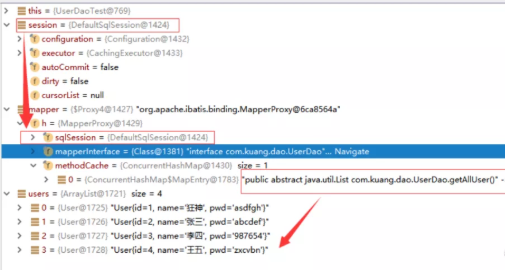
5、本质上利用了jvm的动态代理机制
6、Mybatis详细的执行流程
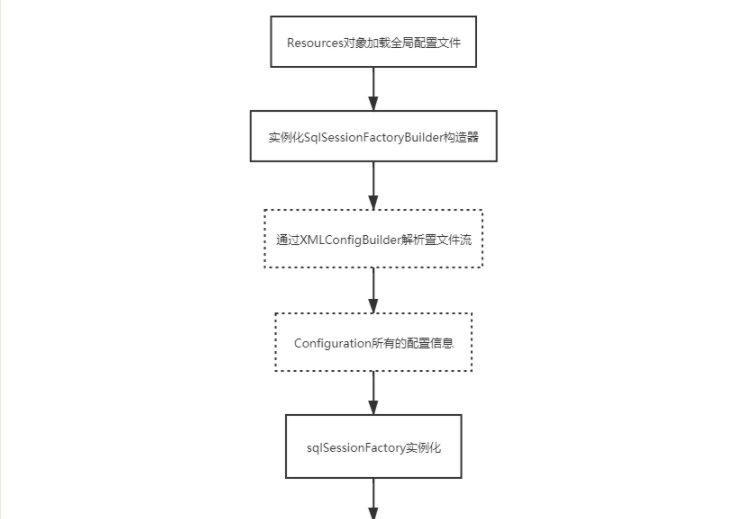
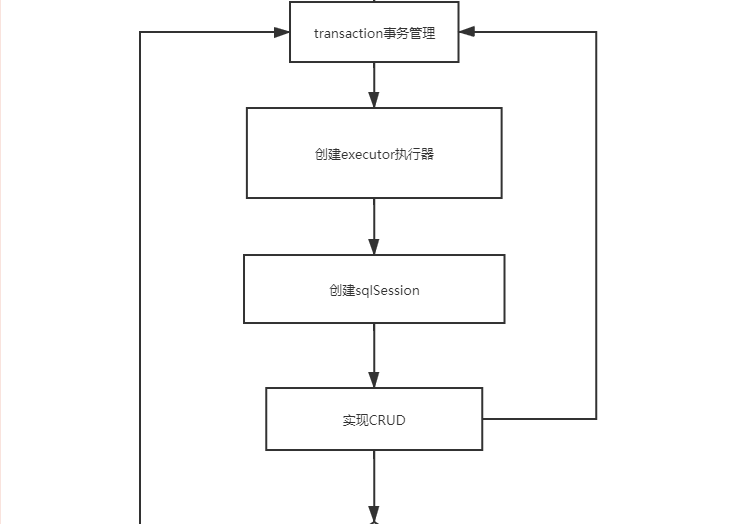
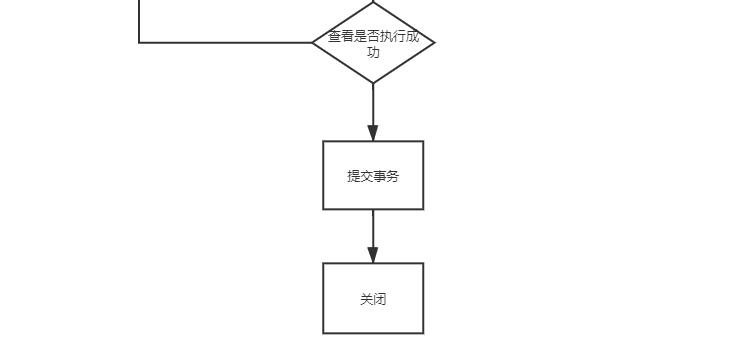
注解增删改
改造MybatisUtils工具类的getSession( ) 方法,重载实现。
//获取SqlSession连接
public static SqlSession getSession(){
return getSession(true); //事务自动提交
}
public static SqlSession getSession(boolean flag){
return sqlSessionFactory.openSession(flag);
}
【注意】确保实体类和数据库字段对应
查询:
1、编写接口方法注解
//根据id查询用户
@Select("select * from user where id = #{id}")
User selectUserById(@Param("id") int id);
2、测试
@Test
public void testSelectUserById() {
SqlSession session = MybatisUtils.getSession();
UserMapper mapper = session.getMapper(UserMapper.class);
User user = mapper.selectUserById(1);
System.out.println(user);
session.close();
}
新增:
1、编写接口方法注解
//添加一个用户
@Insert("insert into user (id,name,pwd) values (#{id},#{name},#{pwd})")
int addUser(User user);
2、测试
@Test
public void testAddUser() {
SqlSession session = MybatisUtils.getSession();
UserMapper mapper = session.getMapper(UserMapper.class);
User user = new User(6, "秦疆", "123456");
mapper.addUser(user);
session.close();
}
修改:
1、编写接口方法注解
//修改一个用户
@Update("update user set name=#{name},pwd=#{pwd} where id = #{id}")
int updateUser(User user);
2、测试
@Test
public void testUpdateUser() {
SqlSession session = MybatisUtils.getSession();
UserMapper mapper = session.getMapper(UserMapper.class);
User user = new User(6, "秦疆", "zxcvbn");
mapper.updateUser(user);
session.close();
}
删除:
1、编写接口方法注解
//根据id删除用
@Delete("delete from user where id = #{id}")
int deleteUser(@Param("id")int id);
2、测试
@Test
public void testDeleteUser() {
SqlSession session = MybatisUtils.getSession();
UserMapper mapper = session.getMapper(UserMapper.class);
mapper.deleteUser(6);
session.close();
}
【注意点:增删改一定记得对事务的处理】
关于@Param
@Param注解用于给方法参数起一个名字。以下是总结的使用原则:
- 在方法只接受一个参数的情况下,可以不使用@Param。
- 在方法接受多个参数的情况下,建议一定要使用@Param注解给参数命名。
- 如果参数是 JavaBean , 则不能使用@Param。
- 不使用@Param注解时,参数只能有一个,并且是Javabean。
#与$的区别
-
#{} 的作用主要是替换预编译语句(PrepareStatement)中的占位符? 【推荐使用】
INSERT INTO user (name) VALUES (#{name}); INSERT INTO user (name) VALUES (?); -
${} 的作用是直接进行字符串替换
INSERT INTO user (name) VALUES ('${name}'); INSERT INTO user (name) VALUES ('kuangshen');
使用注解和配置文件协同开发,才是MyBatis的最佳实践!
一对多和多对一处理
多对一
多对一的理解:
-
多个学生对应一个老师
-
如果对于学生这边,就是一个多对一的现象,即从学生这边关联一个老师!
-
数据表设计

CREATE TABLE `teacher` ( `id` INT(10) NOT NULL, `name` VARCHAR(30) DEFAULT NULL, PRIMARY KEY (`id`) ) ENGINE=INNODB DEFAULT CHARSET=utf8 INSERT INTO teacher(`id`, `name`) VALUES (1, '秦老师'); CREATE TABLE `student` ( `id` INT(10) NOT NULL, `name` VARCHAR(30) DEFAULT NULL, `tid` INT(10) DEFAULT NULL, PRIMARY KEY (`id`), KEY `fktid` (`tid`), CONSTRAINT `fktid` FOREIGN KEY (`tid`) REFERENCES `teacher` (`id`) ) ENGINE=INNODB DEFAULT CHARSET=utf8 INSERT INTO `student` (`id`, `name`, `tid`) VALUES ('1', '小明', '1'); INSERT INTO `student` (`id`, `name`, `tid`) VALUES ('2', '小红', '1'); INSERT INTO `student` (`id`, `name`, `tid`) VALUES ('3', '小张', '1'); INSERT INTO `student` (`id`, `name`, `tid`) VALUES ('4', '小李', '1'); INSERT INTO `student` (`id`, `name`, `tid`) VALUES ('5', '小王', '1');
搭建测试环境
1、IDEA安装Lombok插件
2、引入Maven依赖
<!-- https://mvnrepository.com/artifact/org.projectlombok/lombok -->
<dependency>
<groupId>org.projectlombok</groupId>
<artifactId>lombok</artifactId>
<version>1.16.10</version>
</dependency>
3、创建Javabean类,在代码中增加注解
@Data //GET,SET,ToString,有参,无参构造
public class Teacher {
private int id;
private String name;
}
@Data
public class Student {
private int id;
private String name;
//多个学生可以是同一个老师,即多对一
private Teacher teacher;
}
4、编写实体类对应的Mapper接口 【两个】
- 无论有没有需求,都应该写上,以备后来之需!
public interface StudentMapper {
}
public interface TeacherMapper {
}
5、编写Mapper接口对应的 mapper.xml配置文件 【两个】
- 无论有没有需求,都应该写上,以备后来之需!
<?xml version="1.0" encoding="UTF-8" ?>
<!DOCTYPE mapper
PUBLIC "-//mybatis.org//DTD Mapper 3.0//EN"
"http://mybatis.org/dtd/mybatis-3-mapper.dtd">
<mapper namespace="com.kuang.mapper.StudentMapper">
</mapper>
<?xml version="1.0" encoding="UTF-8" ?>
<!DOCTYPE mapper
PUBLIC "-//mybatis.org//DTD Mapper 3.0//EN"
"http://mybatis.org/dtd/mybatis-3-mapper.dtd">
<mapper namespace="com.kuang.mapper.TeacherMapper">
</mapper>
按查询嵌套处理
1、给StudentMapper接口增加方法
//获取所有学生及对应老师的信息
public List<Student> getStudents();
2、编写对应的Mapper文件
<?xml version="1.0" encoding="UTF-8" ?>
<!DOCTYPE mapper
PUBLIC "-//mybatis.org//DTD Mapper 3.0//EN"
"http://mybatis.org/dtd/mybatis-3-mapper.dtd">
<mapper namespace="com.kuang.mapper.StudentMapper">
<!--
需求:获取所有学生及对应老师的信息
思路:
1. 获取所有学生的信息
2. 根据获取的学生信息的老师ID->获取该老师的信息
3. 思考问题,这样学生的结果集中应该包含老师,该如何处理呢,数据库中我们一般使用关联查询?
1. 做一个结果集映射:StudentTeacher
2. StudentTeacher结果集的类型为 Student
3. 学生中老师的属性为teacher,对应数据库中为tid。
多个 [1,...)学生关联一个老师=> 一对一,一对多
4. 查看官网找到:association – 一个复杂类型的关联;使用它来处理关联查询
-->
<select id="getStudents" resultMap="StudentTeacher">
select * from student where id = #{id}
</select>
<resultMap id="StudentTeacher" type="Student">
<!--association关联属性 property属性名 javaType属性类型 column在多的一方的表中的列名-->
<association property="teacher" column="tid" javaType="Teacher"select="getTeacher"/>
</resultMap>
<!--
这里传递过来的id,只有一个属性的时候,下面可以写任何值
association中column多参数配置:
column="{key=value,key=value}"
其实就是键值对的形式,key是传给下个sql的取值名称,value是片段一中sql查询的字段名。
-->
<select id="getTeacher" resultType="teacher">
select * from teacher where id = #{id}
</select>
</mapper>
分析:
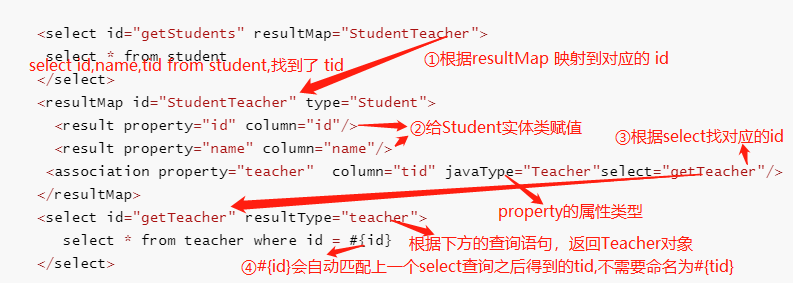
3、编写完毕去Mybatis配置文件中,注册Mapper!
4、注意点说明:
<resultMap id="StudentTeacher" type="Student">
<!--association关联属性 property属性名 javaType属性类型 column在多的一方的表中的列名-->
<association property="teacher" column="{id=tid,name=tid}"javaType="Teacher" select="getTeacher"/>
</resultMap>
<!--
这里传递过来的id,只有一个属性的时候,下面可以写任何值
association中column多参数配置:
column="{key=value,key=value}"
其实就是键值对的形式,key是传给下个sql的取值名称,value是片段一中sql查询的字段名。
-->
<select id="getTeacher" resultType="teacher">
select * from teacher where id = #{id} and name = #{name}
</select>
5、测试
@Test
public void testGetStudents(){
SqlSession session = MybatisUtils.getSession();
StudentMapper mapper = session.getMapper(StudentMapper.class);
List<Student> students = mapper.getStudents();
for (Student student : students){
System.out.println(
"学生名:"+ student.getName()
+"\t老师:"+student.getTeacher().getName());
}
}
按结果嵌套处理
除了上面这种方式,还有其他思路吗?
我们还可以按照结果进行嵌套处理;
1、接口方法编写
public List<Student> getStudents2();
2、编写对应的mapper文件
<!--
按查询结果嵌套处理
思路:
1. 直接查询出结果,进行结果集的映射
-->
<select id="getStudents2" resultMap="StudentTeacher2" >
select s.id sid, s.name sname , t.name tname,t.id tid
from student s,teacher t
where s.tid = t.id
</select>
<resultMap id="StudentTeacher2" type="Student">
<id property="id" column="sid"/>
<result property="name" column="sname"/>
<!--关联对象property 关联对象在Student实体类中的属性-->
<association property="teacher" javaType="Teacher">
<result property="id" column="tid"/>
<result property="name" column="tname"/>
</association>
</resultMap>
3、去mybatis-config文件中注入【此处应该处理过了】
4、测试
@Test
public void testGetStudents2(){
SqlSession session = MybatisUtils.getSession();
StudentMapper mapper = session.getMapper(StudentMapper.class);
List<Student> students = mapper.getStudents2();
for (Student student : students){
System.out.println(
"学生名:"+ student.getName()
+"\t老师:"+student.getTeacher().getName());
}
}
小结
按照查询进行嵌套处理就像SQL中的子查询
按照结果进行嵌套处理就像SQL中的联表查询
一对多
一对多的理解:
- 一个老师拥有多个学生
- 如果对于老师这边,就是一个一对多的现象,即从一个老师下面拥有一群学生(集合)!
实体类编写
@Data
public class Student {
private int id;
private String name;
private int tid;
}
@Data
public class Teacher {
private int id;
private String name;
//一个老师多个学生
private List<Student> students;
}
..... 和之前一样,搭建测试的环境!
按结果嵌套处理
1、TeacherMapper接口编写方法
//获取指定老师,及老师下的所有学生
public Teacher getTeacher(int id);
2、编写接口对应的Mapper配置文件
<mapper namespace="com.kuang.mapper.TeacherMapper">
<!--
思路:
1. 从学生表和老师表中查出学生id,学生姓名,老师姓名
2. 对查询出来的操作做结果集映射
1. 集合的话,使用collection!
JavaType和ofType都是用来指定对象类型的
JavaType是用来指定pojo中属性的类型
ofType指定的是映射到list集合属性中pojo的类型。
-->
<select id="getTeacher" resultMap="TeacherStudent">
select s.id sid, s.name sname , t.name tname, t.id tid
from student s,teacher t
where s.tid = t.id and t.id=#{id}
</select>
<resultMap id="TeacherStudent" type="Teacher">
<result property="name" column="tname"/>
<collection property="students" ofType="Student">
<result property="id" column="sid" />
<result property="name" column="sname" />
<result property="tid" column="tid" />
</collection>
</resultMap>
</mapper>
3、将Mapper文件注册到MyBatis-config文件中
<mappers>
<mapper resource="mapper/TeacherMapper.xml"/>
</mappers>
4、测试
@Test
public void testGetTeacher(){
SqlSession session = MybatisUtils.getSession();
TeacherMapper mapper = session.getMapper(TeacherMapper.class);
Teacher teacher = mapper.getTeacher(1);
System.out.println(teacher.getName());
System.out.println(teacher.getStudents());
}
按查询嵌套处理
1、TeacherMapper接口编写方法
public Teacher getTeacher2(int id);
2、编写接口对应的Mapper配置文件
<select id="getTeacher2" resultMap="TeacherStudent2">
select * from teacher where id = #{id}
</select>
<resultMap id="TeacherStudent2" type="Teacher">
<!--column是一对多的外键 , 写的是一的主键的列名-->
<collection property="students" javaType="ArrayList" ofType="Student"column="id" select="getStudentByTeacherId"/>
</resultMap>
<select id="getStudentByTeacherId" resultType="Student">
select * from student where tid = #{id}
</select>
3、将Mapper文件注册到MyBatis-config文件中
4、测试
@Test
public void testGetTeacher2(){
SqlSession session = MybatisUtils.getSession();
TeacherMapper mapper = session.getMapper(TeacherMapper.class);
Teacher teacher = mapper.getTeacher2(1);
System.out.println(teacher.getName());
System.out.println(teacher.getStudents());
}
小结
1、关联-association
2、集合-collection
3、所以association是用于一对一和多对一,而collection是用于一对多的关系
4、JavaType和ofType都是用来指定对象类型的
- JavaType是用来指定pojo中属性的类型
- ofType指定的是映射到list集合属性中pojo的类型。
注意说明:
1、保证SQL的可读性,尽量通俗易懂
2、根据实际要求,尽量编写性能更高的SQL语句
3、注意属性名和字段不一致的问题
4、注意一对多和多对一 中:字段和属性对应的问题
5、尽量使用Log4j,通过日志来查看自己的错误
动态SQL
什么是动态SQL:动态SQL指的是根据不同的查询条件 , 生成不同的Sql语句.
官网描述:
MyBatis 的强大特性之一便是它的动态 SQL。如果你有使用 JDBC 或其它类似框架的经验,你就能体会到根据不同条件拼接 SQL 语句的痛苦。例如拼接时要确保不能忘记添加必要的空格,还要注意去掉列表最后一个列名的逗号。利用动态 SQL 这一特性可以彻底摆脱这种痛苦。
虽然在以前使用动态 SQL 并非一件易事,但正是 MyBatis 提供了可以被用在任意 SQL 映射语句中的强大的动态 SQL 语言得以改进这种情形。
动态 SQL 元素和 JSTL 或基于类似 XML 的文本处理器相似。在 MyBatis 之前的版本中,有很多元素需要花时间了解。MyBatis 3 大大精简了元素种类,现在只需学习原来一半的元素便可。MyBatis 采用功能强大的基于 OGNL 的表达式来淘汰其它大部分元素。
-------------------------------
- if
- choose (when, otherwise)
- trim (where, set)
- foreach
-------------------------------
我们之前写的 SQL 语句都比较简单,如果有比较复杂的业务,我们需要写复杂的 SQL 语句,往往需要拼接,而拼接 SQL ,稍微不注意,由于引号,空格等缺失可能都会导致错误。
那么怎么去解决这个问题呢?这就要使用 mybatis 动态SQL,通过 if, choose, when, otherwise, trim, where, set, foreach等标签,可组合成非常灵活的SQL语句,从而在提高 SQL 语句的准确性的同时,也大大提高了开发人员的效率。
搭建环境
新建一个数据库表:blog
字段:id,title,author,create_time,views
CREATE TABLE `blog` (
`id` varchar(50) NOT NULL COMMENT '博客id',
`title` varchar(100) NOT NULL COMMENT '博客标题',
`author` varchar(30) NOT NULL COMMENT '博客作者',
`create_time` datetime NOT NULL COMMENT '创建时间',
`views` int(30) NOT NULL COMMENT '浏览量'
) ENGINE=InnoDB DEFAULT CHARSET=utf8
1、创建Mybatis基础工程
2、IDutil工具类
public class IDUtil {
//返回一个唯一的id值
public static String genId(){
return UUID.randomUUID().toString().replaceAll("-","");
}
}
3、实体类编写 【注意set方法作用】
import java.util.Date;
public class Blog {
private String id;
private String title;
private String author;
private Date createTime;
private int views;
//set,get....
}
4、编写Mapper接口及xml文件
public interface BlogMapper {
}
<?xml version="1.0" encoding="UTF-8" ?>
<!DOCTYPE mapper
PUBLIC "-//mybatis.org//DTD Mapper 3.0//EN"
"http://mybatis.org/dtd/mybatis-3-mapper.dtd">
<mapper namespace="com.kuang.mapper.BlogMapper">
</mapper>
5、mybatis核心配置文件,下划线驼峰自动转换,例如数据库表中某一字段last-name,javaBean类中某一属性lastName,则在映射的时候字段名last-name会自动转换为属性名lastName
<settings>
<!--下划线驼峰自动转换-->
<setting name="mapUnderscoreToCamelCase" value="true"/>
<setting name="logImpl" value="STDOUT_LOGGING"/>
</settings>
<!--注册Mapper.xml-->
<mappers>
<mapper resource="mapper/BlogMapper.xml"/>
</mappers>
6、插入初始数据
编写接口
//新增一个博客
int addBlog(Blog blog);
sql配置文件
<insert id="addBlog" parameterType="blog">
insert into blog (id, title, author, create_time, views)
values (#{id},#{title},#{author},#{createTime},#{views});
</insert>
初始化博客方法
@Test
public void addInitBlog(){
SqlSession session = MybatisUtils.getSession();
BlogMapper mapper = session.getMapper(BlogMapper.class);
Blog blog = new Blog();
blog.setId(IDUtil.genId());
blog.setTitle("Mybatis如此简单");
blog.setAuthor("狂神说");
blog.setCreateTime(new Date());
blog.setViews(9999);
mapper.addBlog(blog);
blog.setId(IDUtil.genId());
blog.setTitle("Java如此简单");
mapper.addBlog(blog);
blog.setId(IDUtil.genId());
blog.setTitle("Spring如此简单");
mapper.addBlog(blog);
blog.setId(IDUtil.genId());
blog.setTitle("微服务如此简单");
mapper.addBlog(blog);
session.close();
}
初始化数据完毕!
if
需求:根据作者名字和博客名字来查询博客!如果作者名字为空,那么只根据博客名字查询,反之,则根据作者名来查询
1、编写接口类
//需求1
List<Blog> queryBlogIf(Map map);
2、编写SQL语句
<!--需求1:
根据作者名字和博客名字来查询博客!
如果作者名字为空,那么只根据博客名字查询,反之,则根据作者名来查询
select * from blog where title = #{title} and author = #{author}
-->
<select id="queryBlogIf" parameterType="map" resultType="blog">
select * from blog where
<if test="title != null">
title = #{title}
</if>
<if test="author != null">
and author = #{author}
</if>
</select>
3、测试
@Test
public void testQueryBlogIf(){
SqlSession session = MybatisUtils.getSession();
BlogMapper mapper = session.getMapper(BlogMapper.class);
HashMap<String, String> map = new HashMap<String, String>();
map.put("title","Mybatis如此简单");
map.put("author","狂神说");
List<Blog> blogs = mapper.queryBlogIf(map);
System.out.println(blogs);
session.close();
}
这样写我们可以看到,如果 author 等于 null,那么查询语句为 select * from user where title=#{title},但是如果title为空呢?那么查询语句为 select * from user where and author=#{author},这是错误的 SQL 语句,如何解决呢?请看下面的 where 语句!
where
修改上面的SQL语句;
<select id="queryBlogIf" parameterType="map" resultType="blog">
select * from blog
<where>
<if test="title != null">
title = #{title}
</if>
<if test="author != null">
and author = #{author}
</if>
</where>
</select>
这个“where”标签会知道如果它包含的标签中有返回值的话,它就插入一个‘where’。此外,如果标签返回的内容是以AND 或OR 开头的,则它会剔除掉。
set
同理,上面的对于查询 SQL 语句包含 where 关键字,如果在进行更新操作的时候,含有 set 关键词,我们怎么处理呢?
1、编写接口方法
int updateBlog(Map map);
2、sql配置文件
<!--注意set是用的逗号隔开-->
<update id="updateBlog" parameterType="map">
update blog
<set>
<if test="title != null">
title = #{title},
</if>
<if test="author != null">
author = #{author}
</if>
</set>
where id = #{id};
</update>
3、测试
@Test
public void testUpdateBlog(){
SqlSession session = MybatisUtils.getSession();
BlogMapper mapper = session.getMapper(BlogMapper.class);
HashMap<String, String> map = new HashMap<String, String>();
map.put("title","动态SQL");
map.put("author","秦疆");
map.put("id","9d6a763f5e1347cebda43e2a32687a77");
mapper.updateBlog(map);
session.close();
}
SQL片段
有时候可能某个 sql 语句我们用的特别多,为了增加代码的重用性,简化代码,我们需要将这些代码抽取出来,然后使用时直接调用。
提取SQL片段:
<sql id="if-title-author">
<if test="title != null">
title = #{title}
</if>
<if test="author != null">
and author = #{author}
</if>
</sql>
引用SQL片段:
<select id="queryBlogIf" parameterType="map" resultType="blog">
select * from blog
<where>
<!-- 引用 sql 片段,如果refid 指定的不在本文件中,那么需要在前面加上 namespace -->
<include refid="if-title-author"></include>
<!-- 在这里还可以引用其他的 sql 片段 -->
</where>
</select>
注意:
①、最好基于 单表来定义 sql 片段,提高片段的可重用性
②、在 sql 片段中不要包括 where
Foreach
将数据库中前三个数据的id修改为1,2,3;
需求:我们需要查询 blog 表中 id 分别为1,2,3的博客信息
1、编写接口
List<Blog> queryBlogForeach(Map map);
2、编写SQL语句
<select id="queryBlogForeach" parameterType="map"resultType="blog">
select * from blog
<where>
<!--
collection:指定输入对象中的集合属性
item:每次遍历生成的对象
open:开始遍历时的拼接字符串
close:结束时拼接的字符串
separator:遍历对象之间需要拼接的字符串
select * from blog where 1=1 and (id=1 or id=2 or id=3)
-->
<foreach collection="ids" item="id" open="and (" close=")"separator="or">
id=#{id}
</foreach>
</where>
</select>
3、测试
@Test
public void testQueryBlogForeach(){
SqlSession session = MybatisUtils.getSession();
BlogMapper mapper = session.getMapper(BlogMapper.class);
HashMap map = new HashMap();
List<Integer> ids = new ArrayList<Integer>();
ids.add(1);
ids.add(2);
ids.add(3);
map.put("ids",ids);
List<Blog> blogs = mapper.queryBlogForeach(map);
System.out.println(blogs);
session.close();
}
小结:其实动态 sql 语句的编写往往就是一个拼接的问题,为了保证拼接准确,我们最好首先要写原生的 sql 语句出来,然后在通过 mybatis 动态sql 对照着改,防止出错。多在实践中使用才是熟练掌握它的技巧。
尚硅谷的动态SQL笔记
<?xml version="1.0" encoding="UTF-8"?>
<!DOCTYPE mapper
PUBLIC "-//mybatis.org//DTD Mapper 3.0//EN"
"http://mybatis.org/dtd/mybatis-3-mapper.dtd">
<mapper namespace="com.atguigu.mybatis.dao.EmployeeMapperDynamicSQL">
<!--
• if:判断
• choose (when, otherwise):分支选择;带了break的swtich-case
如果带了id就用id查,如果带了lastName就用lastName查;只会进入其中一个
• trim 字符串截取(where(封装查询条件), set(封装修改条件))
• foreach 遍历集合
-->
<!-- 查询员工,要求,携带了哪个字段查询条件就带上这个字段的值 -->
<!-- public List<Employee> getEmpsByConditionIf(Employee employee); -->
<select id="getEmpsByConditionIf" resultType="com.atguigu.mybatis.bean.Employee">
select * from tbl_employee
<!-- where -->
<where>
<!-- test:判断表达式(OGNL)
OGNL参照PPT或者官方文档。
c:if test
从参数中取值进行判断
遇见特殊符号应该去写转义字符:
&&:
-->
<if test="id!=null">
id=#{id}
</if>
<if test="lastName!=null && lastName!=""">
and last_name like #{lastName}
</if>
<if test="email!=null and email.trim()!=""">
and email=#{email}
</if>
<!-- ognl会进行字符串与数字的转换判断 "0"==0 -->
<if test="gender==0 or gender==1">
and gender=#{gender}
</if>
</where>
</select>
<!--public List<Employee> getEmpsByConditionTrim(Employee employee); -->
<select id="getEmpsByConditionTrim" resultType="com.atguigu.mybatis.bean.Employee">
select * from tbl_employee
<!-- 后面多出的and或者or where标签不能解决
prefix="":前缀:trim标签体中是整个字符串拼串 后的结果。
prefix给拼串后的整个字符串加一个前缀
prefixOverrides="":
前缀覆盖: 去掉整个字符串前面多余的字符
suffix="":后缀
suffix给拼串后的整个字符串加一个后缀
suffixOverrides=""
后缀覆盖:去掉整个字符串后面多余的字符
-->
<!-- 自定义字符串的截取规则 -->
<trim prefix="where" suffixOverrides="and">
<if test="id!=null">
id=#{id} and
</if>
<if test="lastName!=null && lastName!=""">
last_name like #{lastName} and
</if>
<if test="email!=null and email.trim()!=""">
email=#{email} and
</if>
<!-- ognl会进行字符串与数字的转换判断 "0"==0 -->
<if test="gender==0 or gender==1">
gender=#{gender}
</if>
</trim>
</select>
<select id="getEmpsByConditionChoose" resultType="com.atguigu.mybatis.bean.Employee">
select * from tbl_employee
<where>
<!-- 如果带了id就用id查,如果带了lastName就用lastName查;只会进入其中一个 -->
<choose>
<when test="id!=null">
id=#{id}
</when>
<when test="lastName!=null">
last_name like #{lastName}
</when>
<when test="email!=null">
email = #{email}
</when>
<otherwise>
gender = 0
</otherwise>
</choose>
</where>
</select>
<!--public void updateEmp(Employee employee); -->
<update id="updateEmp">
<!-- Set标签的使用 -->
update tbl_employee
<set>
<if test="lastName!=null">
last_name=#{lastName},
</if>
<if test="email!=null">
email=#{email},
</if>
<if test="gender!=null">
gender=#{gender}
</if>
</set>
where id=#{id}
<!--
Trim:更新拼串
update tbl_employee
<trim prefix="set" suffixOverrides=",">
<if test="lastName!=null">
last_name=#{lastName},
</if>
<if test="email!=null">
email=#{email},
</if>
<if test="gender!=null">
gender=#{gender}
</if>
</trim>
where id=#{id} -->
</update>
<!--public List<Employee> getEmpsByConditionForeach(List<Integer> ids); -->
<select id="getEmpsByConditionForeach" resultType="com.atguigu.mybatis.bean.Employee">
select * from tbl_employee
<!--
collection:指定要遍历的集合:
list类型的参数会特殊处理封装在map中,map的key就叫list
item:将当前遍历出的元素赋值给指定的变量
separator:每个元素之间的分隔符
open:遍历出所有结果拼接一个开始的字符
close:遍历出所有结果拼接一个结束的字符
index:索引。遍历list的时候是index就是索引,item就是当前值
遍历map的时候index表示的就是map的key,item就是map的值
#{变量名}就能取出变量的值也就是当前遍历出的元素
-->
<foreach collection="ids" item="item_id" separator=","
open="where id in(" close=")">
#{item_id}
</foreach>
</select>
<!-- 批量保存 -->
<!--public void addEmps(@Param("emps")List<Employee> emps); -->
<!--MySQL下批量保存:可以foreach遍历 mysql支持values(),(),()语法-->
<insert id="addEmps">
insert into tbl_employee(
<include refid="insertColumn"></include>
)
values
<foreach collection="emps" item="emp" separator=",">
(#{emp.lastName},#{emp.email},#{emp.gender},#{emp.dept.id})
</foreach>
</insert><!-- -->
<!-- 这种方式需要数据库连接属性allowMultiQueries=true;
这种分号分隔多个sql可以用于其他的批量操作(删除,修改) -->
<!-- <insert id="addEmps">
<foreach collection="emps" item="emp" separator=";">
insert into tbl_employee(last_name,email,gender,d_id)
values(#{emp.lastName},#{emp.email},#{emp.gender},#{emp.dept.id})
</foreach>
</insert> -->
<!-- Oracle数据库批量保存:
Oracle不支持values(),(),()
Oracle支持的批量方式
1、多个insert放在begin - end里面
begin
insert into employees(employee_id,last_name,email)
values(employees_seq.nextval,'test_001','test_001@atguigu.com');
insert into employees(employee_id,last_name,email)
values(employees_seq.nextval,'test_002','test_002@atguigu.com');
end;
2、利用中间表:
insert into employees(employee_id,last_name,email)
select employees_seq.nextval,lastName,email from(
select 'test_a_01' lastName,'test_a_e01' email from dual
union
select 'test_a_02' lastName,'test_a_e02' email from dual
union
select 'test_a_03' lastName,'test_a_e03' email from dual
)
-->
<insert id="addEmps" databaseId="oracle">
<!-- oracle第一种批量方式 -->
<!-- <foreach collection="emps" item="emp" open="begin" close="end;">
insert into employees(employee_id,last_name,email)
values(employees_seq.nextval,#{emp.lastName},#{emp.email});
</foreach> -->
<!-- oracle第二种批量方式 -->
insert into employees(
<!-- 引用外部定义的sql -->
<include refid="insertColumn">
<property name="testColomn" value="abc"/>
</include>
)
<foreach collection="emps" item="emp" separator="union"
open="select employees_seq.nextval,lastName,email from("
close=")">
select #{emp.lastName} lastName,#{emp.email} email from dual
</foreach>
</insert>
<!-- 两个内置参数:
不只是方法传递过来的参数可以被用来判断,取值。。。
mybatis默认还有两个内置参数:
_parameter:代表整个参数
单个参数:_parameter就是这个参数
多个参数:参数会被封装为一个map;_parameter就是代表这个map
_databaseId:如果配置了databaseIdProvider标签(在mapper-config.xml)。
_databaseId就是代表当前数据库的别名oracle
-->
<!--public List<Employee> getEmpsTestInnerParameter(Employee employee); -->
<select id="getEmpsTestInnerParameter" resultType="com.atguigu.mybatis.bean.Employee">
<!-- bind:可以将OGNL表达式的值绑定到一个变量中,方便后来引用这个变量的值 -->
<bind name="_lastName" value="'%'+lastName+'%'"/>
<if test="_databaseId=='mysql'">
select * from tbl_employee
<if test="_parameter!=null">
where last_name like #{lastName}
</if>
</if>
<if test="_databaseId=='oracle'">
select * from employees
<if test="_parameter!=null">
where last_name like #{_parameter.lastName}
</if>
</if>
</select>
<!--
抽取可重用的sql片段。方便后面引用
1、sql抽取:经常将要查询的列名,或者插入用的列名抽取出来方便引用
2、include来引用已经抽取的sql:
3、include还可以自定义一些property,sql标签内部就能使用自定义的属性
include-property:取值的正确方式${prop},
#{不能使用这种方式}
-->
<sql id="insertColumn">
<if test="_databaseId=='oracle'">
employee_id,last_name,email
</if>
<if test="_databaseId=='mysql'">
last_name,email,gender,d_id
</if>
</sql>
</mapper>
缓存
简介
1、什么是缓存 [ Cache ]?
- 存在内存中的临时数据。
- 将用户经常查询的数据放在缓存(内存)中,用户去查询数据就不用从磁盘上(关系型数据库数据文件)查询,从缓存中查询,从而提高查询效率,解决了高并发系统的性能问题。
2、为什么使用缓存?
- 减少和数据库的交互次数,减少系统开销,提高系统效率。
3、什么样的数据能使用缓存?
- 经常查询并且不经常改变的数据。
mybatis缓存
缓存流程图:
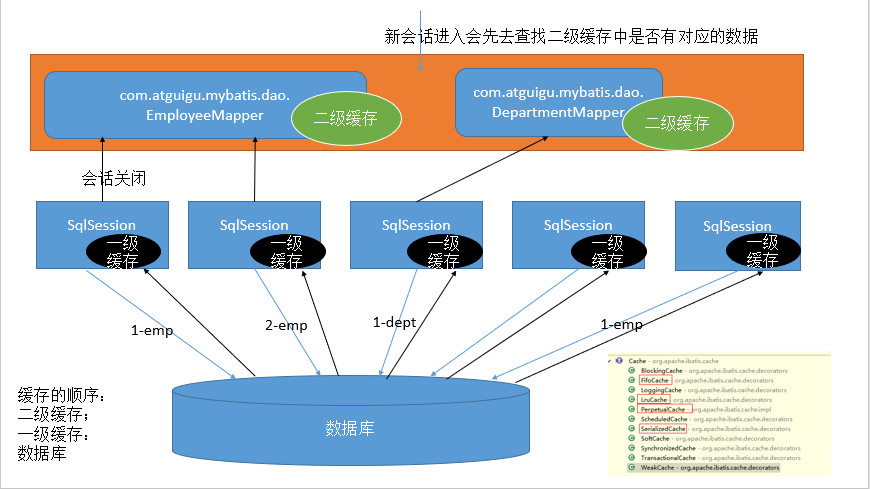
Cache接口实现类
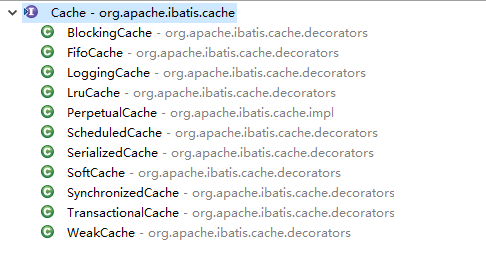
1、什么是缓存 [ Cache ]?
- 存在内存中的临时数据。
- 将用户经常查询的数据放在缓存(内存)中,用户去查询数据就不用从磁盘上(关系型数据库数据文件)查询,从缓存中查询,从而提高查询效率,解决了高并发系统的性能问题。
2、为什么使用缓存?
- 减少和数据库的交互次数,减少系统开销,提高系统效率。
3、什么样的数据能使用缓存?
-
经常查询并且不经常改变的数据。
-
MyBatis包含一个非常强大的查询缓存特性,它可以非常方便地定制和配置缓存。缓存可以极大的提升查询效率。
-
MyBatis系统中默认定义了两级缓存:一级缓存和二级缓存
-
-
默认情况下,只有一级缓存开启。(SqlSession级别的缓存,也称为本地缓存)
-
二级缓存需要手动开启和配置,他是基于namespace级别的缓存。
-
为了提高扩展性,MyBatis定义了缓存接口Cache。我们可以通过实现Cache接口来自定义二级缓存
-
一级缓存
一级缓存也叫本地缓存:
- 与数据库同一次会话期间查询到的数据会放在本地缓存中。
- 以后如果需要获取相同的数据,直接从缓存中拿,没必须再去查询数据库;
测试
1、在mybatis中加入日志,方便测试结果
2、编写接口方法
//根据id查询用户
User queryUserById(@Param("id") int id);
3、接口对应的Mapper文件
<select id="queryUserById" resultType="user">
select * from user where id = #{id}
</select>
4、测试
@Test
public void testQueryUserById(){
SqlSession session = MybatisUtils.getSession();
UserMapper mapper = session.getMapper(UserMapper.class);
User user = mapper.queryUserById(1);
System.out.println(user);
User user2 = mapper.queryUserById(1);
System.out.println(user2);
System.out.println(user==user2);
session.close();
}
5、结果分析
一级缓存失效的四种情况
一级缓存是SqlSession级别的缓存,是一直开启的,我们关闭不了它;
一级缓存失效情况:没有使用到当前的一级缓存,效果就是,还需要再向数据库中发起一次查询请求!
1、sqlSession不同
@Test
public void testQueryUserById(){
SqlSession session = MybatisUtils.getSession();
SqlSession session2 = MybatisUtils.getSession();
UserMapper mapper = session.getMapper(UserMapper.class);
UserMapper mapper2 = session2.getMapper(UserMapper.class);
User user = mapper.queryUserById(1);
System.out.println(user);
User user2 = mapper2.queryUserById(1);
System.out.println(user2);
System.out.println(user==user2);
session.close();
session2.close();
}
观察结果:发现发送了两条SQL语句!
结论:每个sqlSession中的缓存相互独立
2、sqlSession相同,查询条件不同
@Test
public void testQueryUserById(){
SqlSession session = MybatisUtils.getSession();
UserMapper mapper = session.getMapper(UserMapper.class);
UserMapper mapper2 = session.getMapper(UserMapper.class);
User user = mapper.queryUserById(1);
System.out.println(user);
User user2 = mapper2.queryUserById(2);
System.out.println(user2);
System.out.println(user==user2);
session.close();
}
观察结果:发现发送了两条SQL语句!很正常的理解
结论:当前缓存中,不存在这个数据
3、sqlSession相同,两次查询之间执行了增删改操作!
增加方法
//修改用户
int updateUser(Map map);
编写SQL
<update id="updateUser" parameterType="map">
update user set name = #{name} where id = #{id}
</update>
测试
@Test
public void testQueryUserById(){
SqlSession session = MybatisUtils.getSession();
UserMapper mapper = session.getMapper(UserMapper.class);
User user = mapper.queryUserById(1);
System.out.println(user);
HashMap map = new HashMap();
map.put("name","kuangshen");
map.put("id",4);
mapper.updateUser(map);
User user2 = mapper.queryUserById(1);
System.out.println(user2);
System.out.println(user==user2);
session.close();
}
观察结果:查询在中间执行了增删改操作后,重新执行了
结论:因为增删改操作可能会对当前数据产生影响
4、sqlSession相同,手动清除一级缓存
@Test
public void testQueryUserById(){
SqlSession session = MybatisUtils.getSession();
UserMapper mapper = session.getMapper(UserMapper.class);
User user = mapper.queryUserById(1);
System.out.println(user);
session.clearCache();//手动清除缓存
User user2 = mapper.queryUserById(1);
System.out.println(user2);
System.out.println(user==user2);
session.close();
}
一级缓存就是一个map
二级缓存
-
二级缓存也叫全局缓存,一级缓存作用域太低了,所以诞生了二级缓存
-
基于namespace级别的缓存,一个名称空间,对应一个二级缓存;
-
工作机制
-
- 一个会话查询一条数据,这个数据就会被放在当前会话的一级缓存中;
- 如果当前会话关闭了,这个会话对应的一级缓存就没了;但是我们想要的是,会话关闭了,一级缓存中的数据被保存到二级缓存中;
- 新的会话查询信息,就可以从二级缓存中获取内容;
- 不同的mapper查出的数据会放在自己对应的缓存(map)中;
使用步骤
1、开启全局缓存 【mybatis-config.xml】
<setting name="cacheEnabled" value="true"/>
2、去每个mapper.xml中配置使用二级缓存,这个配置非常简单;【xxxMapper.xml】
<cache/>
官方示例=====>查看官方文档
<cache
eviction="FIFO"
flushInterval="60000"
size="512"
readOnly="true"/>
这个更高级的配置创建了一个 FIFO 缓存,每隔 60 秒刷新,最多可以存储结果对象或列表的 512 个引用,而且返回的对象被认为是只读的,因此对它们进行修改可能会在不同线程中的调用者产生冲突。
3、代码测试
- 所有的实体类先实现序列化接口
- 测试代码
@Test
public void testQueryUserById(){
SqlSession session = MybatisUtils.getSession();
SqlSession session2 = MybatisUtils.getSession();
UserMapper mapper = session.getMapper(UserMapper.class);
UserMapper mapper2 = session2.getMapper(UserMapper.class);
User user = mapper.queryUserById(1);
System.out.println(user);
session.close();
User user2 = mapper2.queryUserById(1);
System.out.println(user2);
System.out.println(user==user2);
session2.close();
}
结论
- 只要开启了二级缓存,我们在同一个Mapper中的查询,可以在二级缓存中拿到数据
- 查出的数据都会被默认先放在一级缓存中
- 只有会话提交或者关闭以后,一级缓存中的数据才会转到二级缓存中
缓存原理图
EhCache
第三方缓存实现--EhCache: 查看百度百科
Ehcache是一种广泛使用的java分布式缓存,用于通用缓存;
要在应用程序中使用Ehcache,需要引入依赖的jar包
<!-- https://mvnrepository.com/artifact/org.mybatis.caches/mybatis-ehcache -->
<dependency>
<groupId>org.mybatis.caches</groupId>
<artifactId>mybatis-ehcache</artifactId>
<version>1.1.0</version>
</dependency>
在mapper.xml中使用对应的缓存即可
<mapper namespace = “org.acme.FooMapper” >
<cache type = “org.mybatis.caches.ehcache.EhcacheCache” />
</mapper>
编写ehcache.xml文件,如果在加载时未找到/ehcache.xml资源或出现问题,则将使用默认配置。
<?xml version="1.0" encoding="UTF-8"?>
<ehcache xmlns:xsi="http://www.w3.org/2001/XMLSchema-instance"
xsi:noNamespaceSchemaLocation="http://ehcache.org/ehcache.xsd"
updateCheck="false">
<!--
diskStore:为缓存路径,ehcache分为内存和磁盘两级,此属性定义磁盘的缓存位置。参数解释如下:
user.home – 用户主目录
user.dir – 用户当前工作目录
java.io.tmpdir – 默认临时文件路径
-->
<diskStore path="./tmpdir/Tmp_EhCache"/>
<defaultCache
eternal="false"
maxElementsInMemory="10000"
overflowToDisk="false"
diskPersistent="false"
timeToIdleSeconds="1800"
timeToLiveSeconds="259200"
memoryStoreEvictionPolicy="LRU"/>
<cache
name="cloud_user"
eternal="false"
maxElementsInMemory="5000"
overflowToDisk="false"
diskPersistent="false"
timeToIdleSeconds="1800"
timeToLiveSeconds="1800"
memoryStoreEvictionPolicy="LRU"/>
<!--
defaultCache:默认缓存策略,当ehcache找不到定义的缓存时,则使用这个缓存策略。只能定义一个。
-->
<!--
name:缓存名称。
maxElementsInMemory:缓存最大数目
maxElementsOnDisk:硬盘最大缓存个数。
eternal:对象是否永久有效,一但设置了,timeout将不起作用。
overflowToDisk:是否保存到磁盘,当系统当机时
timeToIdleSeconds:设置对象在失效前的允许闲置时间(单位:秒)。仅当eternal=false对象不是永久有效时使用,可选属性,默认值是0,也就是可闲置时间无穷大。
timeToLiveSeconds:设置对象在失效前允许存活时间(单位:秒)。最大时间介于创建时间和失效时间之间。仅当eternal=false对象不是永久有效时使用,默认是0.,也就是对象存活时间无穷大。
diskPersistent:是否缓存虚拟机重启期数据 Whether the disk store persists between restarts of the Virtual Machine. The default value is false.
diskSpoolBufferSizeMB:这个参数设置DiskStore(磁盘缓存)的缓存区大小。默认是30MB。每个Cache都应该有自己的一个缓冲区。
diskExpiryThreadIntervalSeconds:磁盘失效线程运行时间间隔,默认是120秒。
memoryStoreEvictionPolicy:当达到maxElementsInMemory限制时,Ehcache将会根据指定的策略去清理内存。默认策略是LRU(最近最少使用)。你可以设置为FIFO(先进先出)或是LFU(较少使用)。
clearOnFlush:内存数量最大时是否清除。
memoryStoreEvictionPolicy:可选策略有:LRU(最近最少使用,默认策略)、FIFO(先进先出)、LFU(最少访问次数)。
FIFO,first in first out,这个是大家最熟的,先进先出。
LFU, Less Frequently Used,就是上面例子中使用的策略,直白一点就是讲一直以来最少被使用的。如上面所讲,缓存的元素有一个hit属性,hit值最小的将会被清出缓存。
LRU,Least Recently Used,最近最少使用的,缓存的元素有一个时间戳,当缓存容量满了,而又需要腾出地方来缓存新的元素的时候,那么现有缓存元素中时间戳离当前时间最远的元素将被清出缓存。
-->
</ehcache>
尚硅谷-缓存笔记
两级缓存:
一级缓存:(本地缓存):sqlSession级别的缓存。一级缓存是一直开启的;SqlSession级别的一个Map
与数据库同一次会话期间查询到的数据会放在本地缓存中。
以后如果需要获取相同的数据,直接从缓存中拿,没必要再去查询数据库;
一级缓存失效情况(没有使用到当前一级缓存的情况,效果就是,还需要再向数据库发出查询):
1、sqlSession不同。
2、sqlSession相同,查询条件不同.(当前一级缓存中还没有这个数据)
3、sqlSession相同,两次查询之间执行了增删改操作(这次增删改可能对当前数据有影响)
4、sqlSession相同,手动清除了一级缓存(缓存清空)
二级缓存:(全局缓存):基于namespace(Mapper级别)级别的缓存:一个namespace对应一个二级缓存:
工作机制:
1、一个会话,查询一条数据,这个数据就会被放在当前会话的一级缓存中;
2、如果会话关闭;一级缓存中的数据会被保存到二级缓存中;新的会话查询信息,就可以参照二级缓存中的内容;
3、sqlSession===EmployeeMapper==>Employee
DepartmentMapper===>Department
不同namespace查出的数据会放在自己对应的缓存中(map)
效果:数据会从二级缓存中获取
查出的数据都会被默认先放在一级缓存中。
只有会话提交或者关闭以后,一级缓存中的数据才会转移到二级缓存中
使用:
1)、开启全局二级缓存配置(mybatis-config.xml):<setting name="cacheEnabled" value="true"/>
2)、去mapper.xml中配置使用二级缓存(例如EmployeeMapper.xml,DepartmentMapper.xml):
<cache></cache>
3)、我们的POJO需要实现序列化接口
和缓存有关的设置/属性:
1)、cacheEnabled=true:false:关闭缓存(只能关闭二级缓存,一级缓存一直可用的)
2)、每个select标签都有useCache="true":
false:不使用缓存(一级缓存依然使用,一级缓存是无法关闭的,二级缓存不使用)
3)、【每个增删改标签的:flushCache="true":默认为true,(一级二级都会清除)】
增删改执行完成后就会清除缓存;
测试:flushCache="true":一级缓存就清空了;二级也会被清除;
【查询标签】:flushCache="false":
如果flushCache=true;每次查询之后都会清空缓存;缓存是没有被使用的;
4)、sqlSession.clearCache();只是清除当前session的一级缓存;
5)、localCacheScope:本地缓存作用域:(一级缓存SESSION);当前会话的所有数据保存在会话缓存中;STATEMENT:可以禁用一级缓存;
第三方缓存整合:
1)、导入第三方缓存包即可;
2)、导入与第三方缓存整合的适配包;官方有;
3)、mapper.xml中使用自定义缓存
<cache type="org.mybatis.caches.ehcache.EhcacheCache"></cache>

在某个Mapper.xml文件中引入第三方缓存(EhcacheCache),以及cache 中的属性,默认情况下,只填写
'
<mapper namespace="com.atguigu.mybatis.dao.EmployeeMapper">
<cache type="org.mybatis.caches.ehcache.EhcacheCache"></cache>
<!-- <cache eviction="FIFO" flushInterval="60000" readOnly="false" size="1024"></cache> -->
<!--
eviction:缓存的回收策略:
• LRU – 最近最少使用的:移除最长时间不被使用的对象。
• FIFO – 先进先出:按对象进入缓存的顺序来移除它们。
• SOFT – 软引用:移除基于垃圾回收器状态和软引用规则的对象。
• WEAK – 弱引用:更积极地移除基于垃圾收集器状态和弱引用规则的对象。
• 默认的是 LRU。
flushInterval:缓存刷新间隔
缓存多长时间清空一次,默认不清空,设置一个毫秒值
readOnly:是否只读:
true:只读;mybatis认为所有从缓存中获取数据的操作都是只读操作,不会修改数据。
mybatis为了加快获取速度,直接就会将数据在缓存中的引用交给用户。不安全,速度快
false:非只读:mybatis觉得获取的数据可能会被修改。
mybatis会利用序列化&反序列的技术克隆一份新的数据给你。安全,速度慢
size:缓存存放多少元素;
type="":指定自定义缓存的全类名;
实现Cache接口即可;
-->
若当前Mapper没有引入第三方缓存,也可以引用其他的已存在第三方的namespace
<mapper namespace="com.atguigu.mybatis.dao.DepartmentMapper">
<!-- 引用缓存:namespace:指定和哪个名称空间下的缓存一样 -->
<cache-ref namespace="com.atguigu.mybatis.dao.EmployeeMapper"/>
Mybatis-逆向工程
MyBatis Generator简介
-
简称MBG,是一个专门为MyBatis框架使用者定 制的代码生成器,可以快速的根据表生成对应的 映射文件,接口,以及bean类。支持基本的增删 改查,以及QBC风格的条件查询。但是表连接、 存储过程等这些复杂sql的定义需要我们手工编写
使用步骤
步骤1:编写MBG的配置文件
如果是maven工程
<dependency>
<groupId>org.mybatis.generator</groupId>
<artifactId>mybatis-generator</artifactId>
<version>1.4.0</version>
</dependency>
<dependency>
<groupId>org.mybatis.generator</groupId>
<artifactId>mybatis-generator-maven-plugin</artifactId>
<version>1.4.0</version>
</dependency>
如果不是maven工程,导入jar包
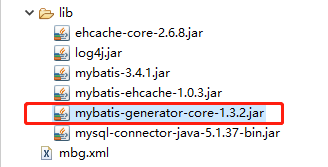
编写 MyBatis Generator 的配置文件mbg.xml
1)jdbcConnection配置数据库连接信息
2)javaModelGenerator配置javaBean的生成策略
3)sqlMapGenerator 配置sql映射文件生成策略
4)javaClientGenerator配置Mapper接口的生成策略 5)table 配置要逆向解析的数据表 tableName:表名 domainObjectName:对应的javaBean名
<!DOCTYPE generatorConfiguration PUBLIC
"-//mybatis.org//DTD MyBatis Generator Configuration 1.0//EN"
"http://mybatis.org/dtd/mybatis-generator-config_1_0.dtd">
<generatorConfiguration>
<context id="simple" targetRuntime="MyBatis3">
<!-- jdbcConnection:指定如何连接到目标数据库 -->
<jdbcConnection driverClass="com.mysql.jdbc.Driver"
connectionURL="jdbc:mysql://localhost:3306/mybatis?allowMultiQueries=true"
userId="root" password="123123" />
<javaTypeResolver>
<property name="forceBigDecimals" value="false" />
</javaTypeResolver>
<!-- javaModelGenerator:指定javaBean的生成策略 targetPackage="test.model":目标包名
targetProject="\MBGTestProject\src":目标工程 -->
<javaModelGenerator
targetPackage="com.atguigu.mybatis.bean" targetProject="./src">
<property name="enableSubPackages" value="true" />
<property name="trimStrings" value="true" />
</javaModelGenerator>
<!-- sqlMapGenerator:sql映射生成策略: -->
<sqlMapGenerator
targetPackage="com.atguigu.mybatis.dao" targetProject="./conf">
<property name="enableSubPackages" value="true" />
</sqlMapGenerator>
<!-- javaClientGenerator:指定mapper接口所在的位置 -->
<javaClientGenerator type="XMLMAPPER"
targetPackage="com.atguigu.mybatis.dao" targetProject="./src">
<property name="enableSubPackages" value="true" />
</javaClientGenerator>
<!-- 指定要逆向分析哪些表:根据表要创建javaBean -->
<table tableName="tbl_dept" domainObjectName="Department" />
<table tableName="tbl_employee" domainObjectName="Employee"></table>
</context>
</generatorConfiguration>
注意: Context标签
- targetRuntime=“MyBatis3“可以生成带条件的增删改查
- targetRuntime=“MyBatis3Simple“可以生成基本的增删改查 如果再次生成,建议将之前生成的数据删除,避免xml向后追加内容出现的问 题。
步骤二:运行代码生成器生成代码
在运行之前,看一下项目中的结构
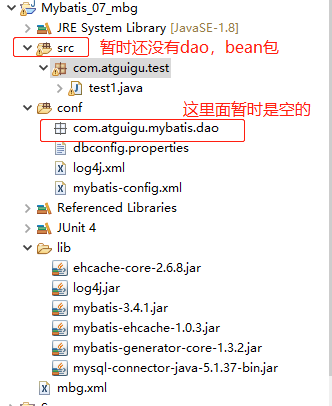
运行代码生成器:
@Test
public void test1() throws Exception {
List<String> warnings = new ArrayList<String>();
boolean overwrite = true;
File configFile = new File("mbg.xml");
ConfigurationParser cp = new ConfigurationParser(warnings);
Configuration config = cp.parseConfiguration(configFile);
DefaultShellCallback callback = new DefaultShellCallback(overwrite);
MyBatisGenerator myBatisGenerator = new MyBatisGenerator(config, callback, warnings);
myBatisGenerator.generate(null);
}
运行结果
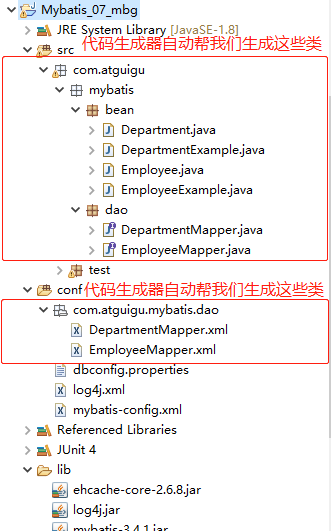
步骤三:测试
上面生成的那些类,已经封装好了增删改查操作,我们只需调用相应的方法即可
selectByPrimaryKey(Integer id)
@Test
public void test2() throws Exception {
SqlSessionFactory sqlSessionFactory = getSqlSessionFactory();
SqlSession openSession = sqlSessionFactory.openSession();
try {
EmployeeMapper mapper = openSession.getMapper(EmployeeMapper.class);
Employee employee = mapper.selectByPrimaryKey(4);
System.out.println(employee);
} finally {
if (openSession != null)
openSession.close();
}
}
结果

xxxExample():用来添加查询条件的
@Test
public void test3() throws Exception {
SqlSessionFactory sqlSessionFactory = getSqlSessionFactory();
SqlSession openSession = sqlSessionFactory.openSession();
try {
EmployeeMapper mapper = openSession.getMapper(EmployeeMapper.class);
//xxxExample就是封装查询条件的
// 1、查询所有
List<Employee> list = mapper.selectByExample(null);
for (Employee employee : list) {
System.out.println(employee);
}
} finally {
if (openSession != null)
openSession.close();
}
}
测试结果

Criteria,主要用来拼接查询条件。若需要填写多个查询条件的,用criteria对象的方法
测试:查询员工名字中有e字母的,和员工性别是1的
@Test
public void test3() throws Exception {
SqlSessionFactory sqlSessionFactory = getSqlSessionFactory();
SqlSession openSession = sqlSessionFactory.openSession();
try {
EmployeeMapper mapper = openSession.getMapper(EmployeeMapper.class);
// 2、查询员工名字中有e字母的,和员工性别是1的
// 封装员工查询条件的example
EmployeeExample example = new EmployeeExample();
// 创建一个Criteria,这个Criteria就是拼装查询条件
// select id, last_name, email, gender, d_id from tbl_employee
// WHERE ( last_name like ? and gender = ? )
Criteria criteria = example.createCriteria();
criteria.andLastNameLike("%三%");
criteria.andGenderEqualTo("1");
List<Employee> list = mapper.selectByExample(example);
for (Employee employee : list) {
System.out.println(employee);
}
} finally {
if (openSession != null)
openSession.close();
}
}
注意:Criteria拼接的查询条件只能是 “且” 的关系,例如
WHERE ( last_name like ? and gender = ? )
如果想拼接的查询条件可以 有 “或” 的关系,重新创建criteria对象,并且调用exmple.or(criteria新对象)
测试:查询员工名字中有"三"字符的,和员工性别是1的 或者 email 中有qq字母的
@Test
public void test3() throws Exception {
SqlSessionFactory sqlSessionFactory = getSqlSessionFactory();
SqlSession openSession = sqlSessionFactory.openSession();
try {
EmployeeMapper mapper = openSession.getMapper(EmployeeMapper.class);
EmployeeExample example = new EmployeeExample();
// 创建一个Criteria,这个Criteria就是拼装查询条件
// select id, last_name, email, gender, d_id from tbl_employee
// WHERE ( last_name like ? and gender = ? ) or email like "%e%"
Criteria criteria = example.createCriteria();
criteria.andLastNameLike("%三%");
criteria.andGenderEqualTo("1");
Criteria criteria2 = example.createCriteria();
criteria2.andEmailLike("%qq%");
example.or(criteria2);
List<Employee> list = mapper.selectByExample(example);
for (Employee employee : list) {
System.out.println(employee);
}
} finally {
if (openSession != null)
openSession.close();
}
}
Mybatis运行原理
1.根据配置文件创建SQLSessionFactory
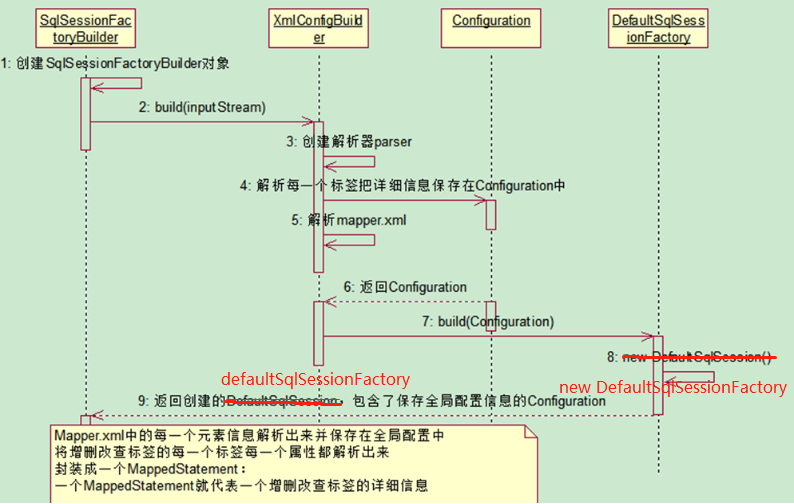
关键代码
public SqlSessionFactory getSqlSessionFactory() throws IOException {
String resource = "mybatis-config.xml";
InputStream inputStream = Resources.getResourceAsStream(resource);
return new SqlSessionFactoryBuilder().build(inputStream);
}
注意:
Configuration封装了所有配置文件的详细信息
把配置文件的信息解析并保存在Configuration对象中,返回包含了Configuration的DefaultSqlSessionFactory对象。

Configuration对象保存了所有配置文件的详细信息
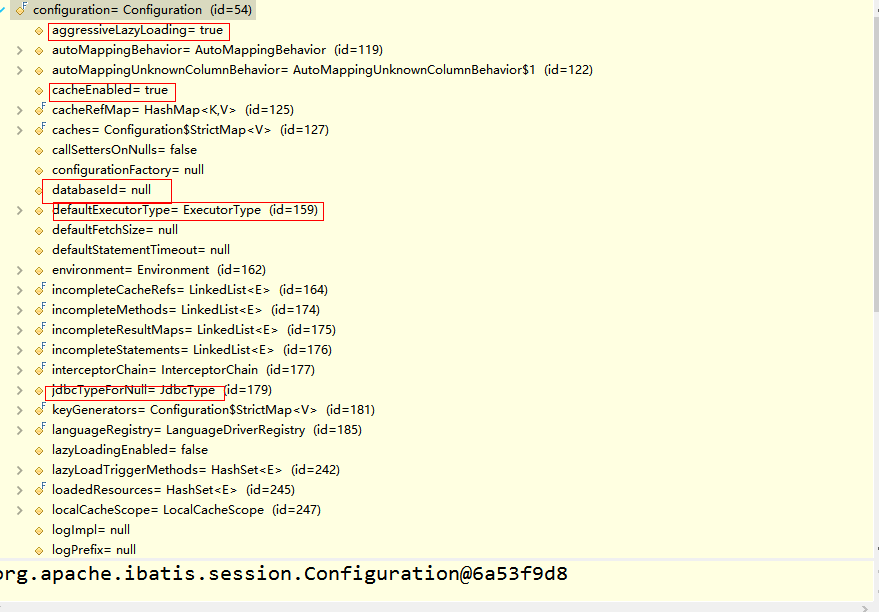
2.创建DefaultSqlSession对象
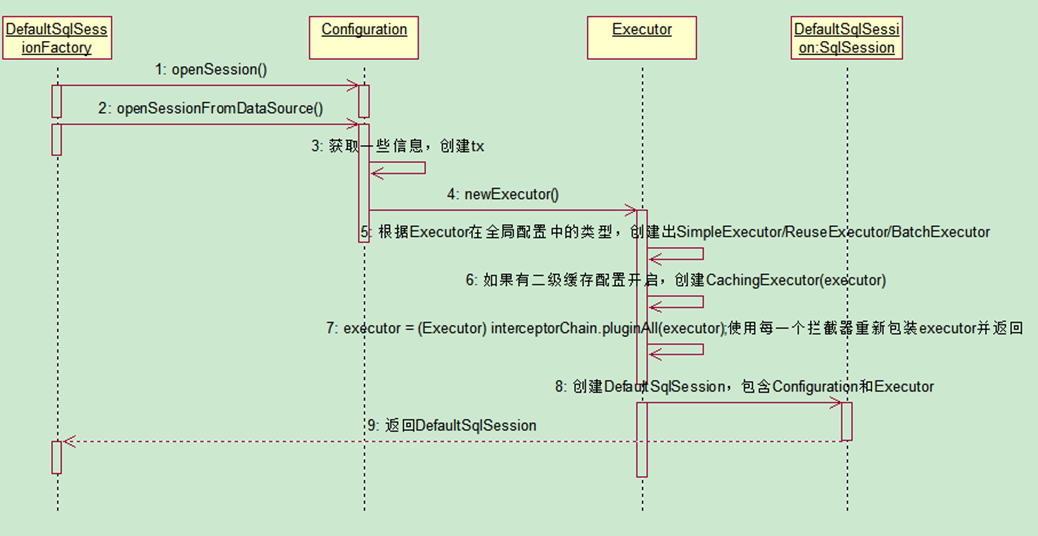
关键代码
SqlSession openSession = sqlSessionFactory.openSession();
注意:
返回SqlSession的实现类DefaultSqlSession对象。里面包含了Executor和Configuration;Executor会在这一步被创建
3.返回getMapper接口的代理对象(包含了SqlSession对象)

执行流程如下:
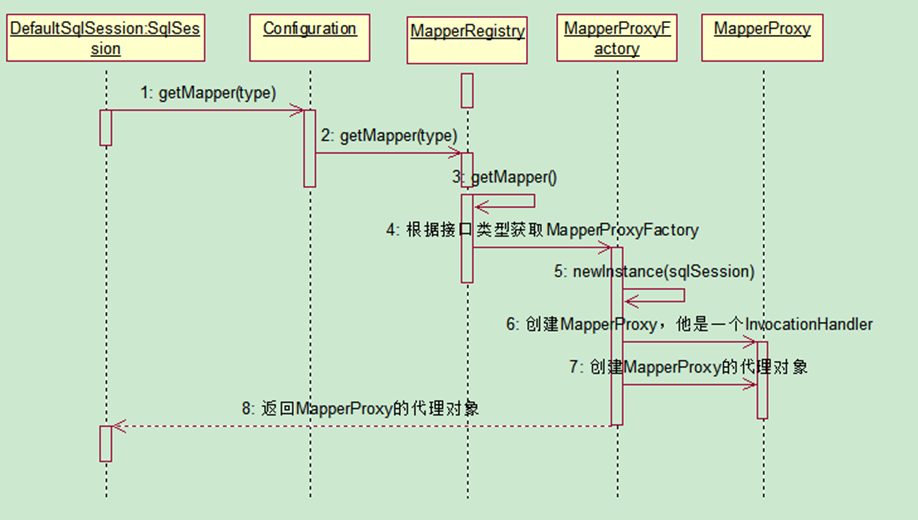
关键代码
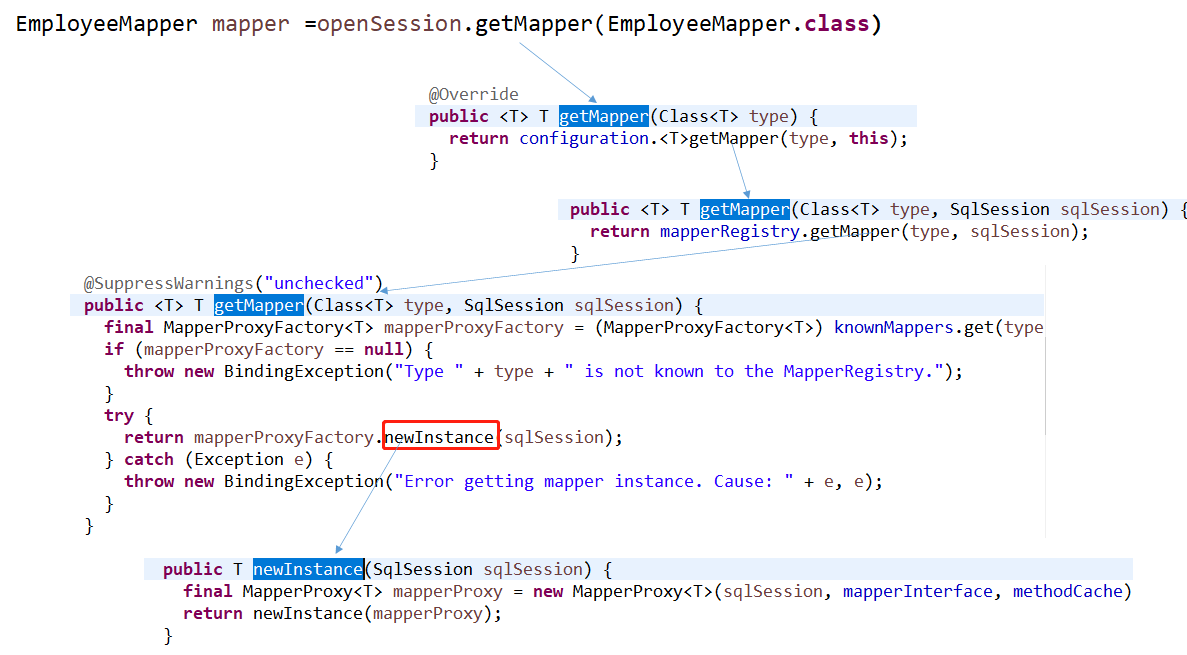
Mapper接口的代理类对象

查询流程
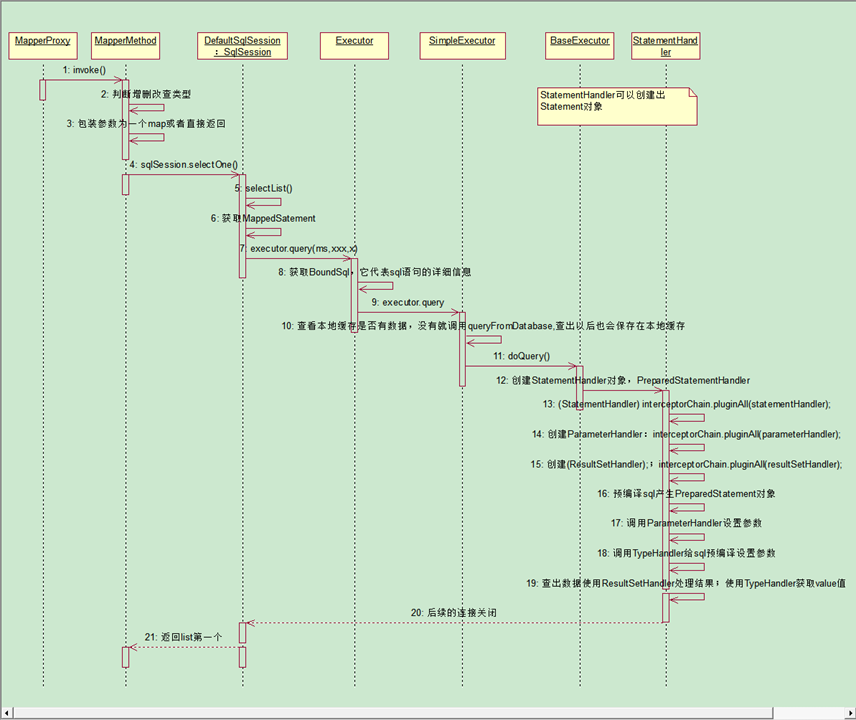
一个MappedStatement代表一个增删改查标签的详细信息
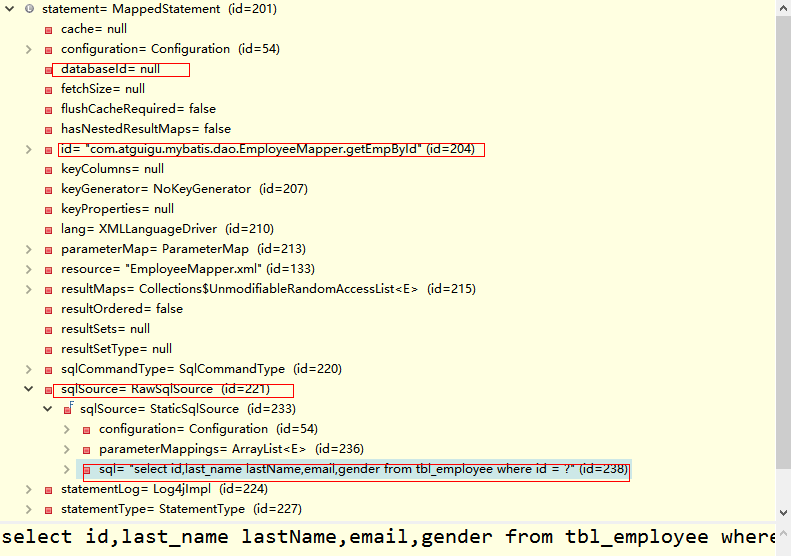
一个BoundSql对象代表一条SQL语句

KnowMapper保存了Mapper接口和Mapper动态代理实例的关系

小结:
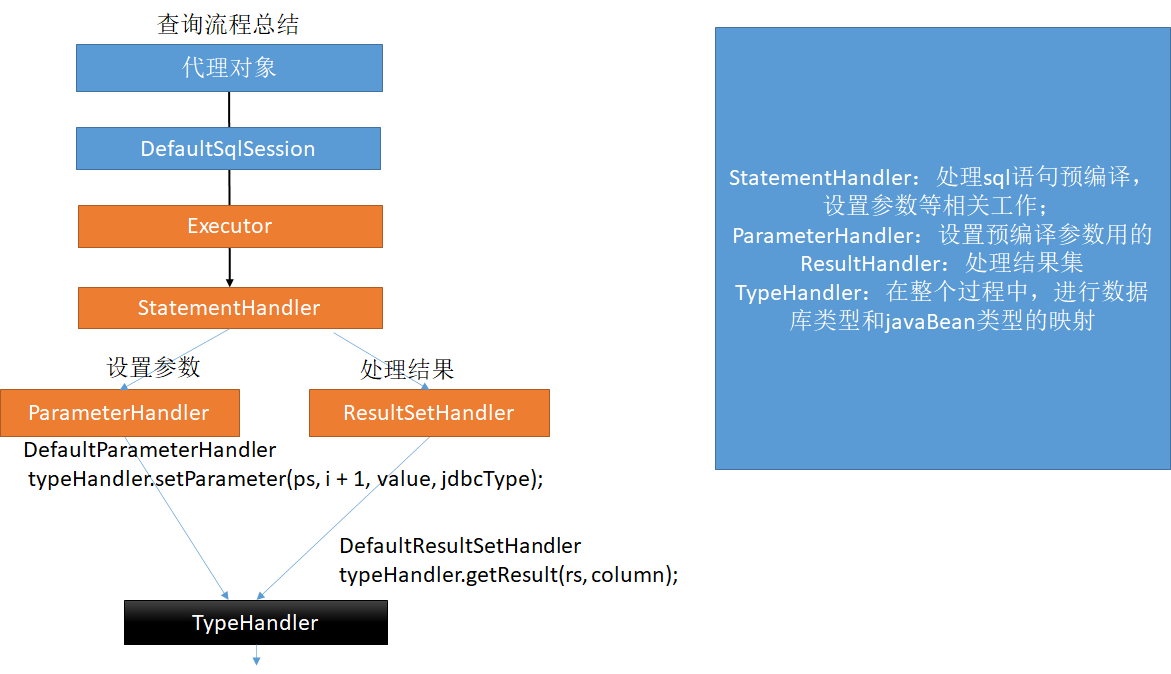
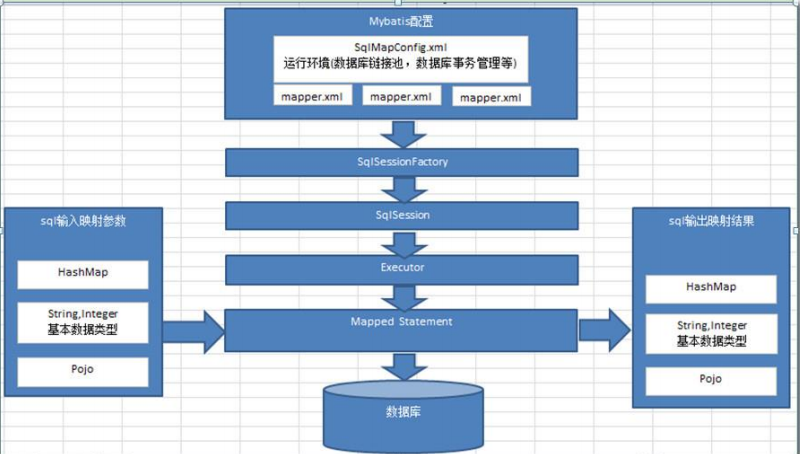
Mybatis四大对象:Executor,StatementHandler,ParameterHandler ResultSetHandler
- Executor是 Mybatis的内部执行器,它负责调用StatementHandler操作数据库,并把结果集通过 ResultSetHandler进行自动映射,另外,他还处理了二级缓存的操作。从这里可以看出,我们也是可以通过插件来实现自定义的二级缓存的。
- StatementHandler是Mybatis直接和数据库执行sql脚本的对象。另外它也实现了Mybatis的一级缓存。这里,我们可以使用插件来实现对一级缓存的操作(禁用等等)。
- ParameterHandler是Mybatis实现Sql入参设置的对象。插件可以改变我们Sql的参数默认设置。
- ResultSetHandler是Mybatis把ResultSet集合映射成POJO的接口对象。我们可以定义插件对Mybatis的结果集自动映射进行修改
/**
* 1、获取sqlSessionFactory对象:
* 解析文件的每一个信息保存在Configuration中,返回包含Configuration的DefaultSqlSession;
* 注意:【MappedStatement】:代表一个增删改查的详细信息
*
* 2、获取sqlSession对象
* 返回一个DefaultSQlSession对象,包含Executor和Configuration;
* 这一步会创建Executor对象;
*
* 3、获取接口的代理对象(MapperProxy)
* getMapper,使用MapperProxyFactory创建一个MapperProxy的代理对象
* 代理对象里面包含了,DefaultSqlSession(Executor)
* 4、执行增删改查方法
*
* 总结:
* 1、根据配置文件(全局,sql映射)初始化出Configuration对象
* 2、创建一个DefaultSqlSession对象,
* 他里面包含Configuration以及
* Executor(根据全局配置文件中的defaultExecutorType创建出对应的Executor)
* 3、DefaultSqlSession.getMapper():拿到Mapper接口对应的MapperProxy;
* 4、MapperProxy里面有(DefaultSqlSession);
* 5、执行增删改查方法:
* 1)、调用DefaultSqlSession的增删改查(Executor);
* 2)、会创建一个StatementHandler对象。
* (同时也会创建出ParameterHandler和ResultSetHandler)
* 3)、调用StatementHandler预编译参数以及设置参数值;
* 使用ParameterHandler来给sql设置参数
* 4)、调用StatementHandler的增删改查方法;
* 5)、ResultSetHandler封装结果
* 注意:
* 四大对象每个创建的时候都有一个interceptorChain.pluginAll(parameterHandler);
*
*/
Mybatis插件开发
概述
Mybatis插件又称拦截器,Mybatis采用责任链模式,通过动态代理组织多个插件(拦截器),通过这些插件可以改变Mybatis的默认行为。MyBatis 允许你在已映射语句执行过程中的某一点进行拦截调用。默认情况下,MyBatis允许使用插件来拦截的方法调用包括:
- Executor (update, query, flushStatements, commit, rollback,getTransaction, close, isClosed) 拦截执行器的方法;
- ParameterHandler (getParameterObject, setParameters) 拦截参数的处理;
- ResultSetHandler (handleResultSets, handleOutputParameters) 拦截结果集的处理;
- StatementHandler (prepare, parameterize, batch, update, query) 拦截Sql语法构建的处理;
插件原理
-
按照插件注解声明,按照插件配置顺序调用插件plugin方法,生成被拦截对象的动态代理
-
多个插件依次生成目标对象的代理对象,层层包裹,先声明的先包裹;形成代理链
-
目标方法执行时依次从外到内执行插件的intercept方法。
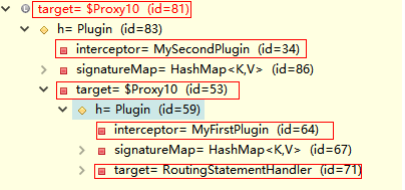
-
多个插件情况下,我们往往需要在某个插件中分离出目标 对象。可以借助MyBatis提供的SystemMetaObject类来进行获 取最后一层的h以及target属性的值
定义插件
1、编写插件实现Interceptor接口,并且实现抽象方法
intercept():拦截目标对象的目标方法的执行,可以增加自定义的方法(AOP思想),
其中Object proceed = invocation.proceed()目标方法的执行
plugin(): 包装目标对象的:为目标对象创建一个代理对象
setProperties(): 将插件注册时 的property属性设置进来
public class MyFirstPlugin implements Interceptor {
/**
* intercept:拦截: 拦截目标对象的目标方法的执行;
*/
@Override
public Object intercept(Invocation invocation) throws Throwable {
// TODO Auto-generated method stub
System.out.println("MyFirstPlugin...intercept:" + invocation.getMethod());
Object target = invocation.getTarget();
System.out.println("当前拦截到的对象:" + target);
// 执行目标方法
Object proceed = invocation.proceed();
// 返回执行后的返回值
return proceed;
}
/**
* plugin: 包装目标对象的:为目标对象创建一个代理对象
*/
@Override
public Object plugin(Object target) {
// 我们可以借助Plugin的wrap方法来使用当前Interceptor包装我们目标对象
System.out.println("MyFirstPlugin...plugin:mybatis将要包装的对象=================" + target);
Object wrap = Plugin.wrap(target, this);
// 返回为当前target创建的动态代理
return wrap;
}
/**
* setProperties: 将插件注册时 的property属性设置进来
*/
@Override
public void setProperties(Properties properties) {
// TODO Auto-generated method stub
System.out.println("插件配置的信息:" + properties);
}
}
2.在类的上方添加@Intercepts注解,完成插件签名
@Intercepts({ @Signature(type = StatementHandler.class, method = "parameterize", args = java.sql.Statement.class) })
public class MyFirstPlugin implements Interceptor {
}
3.在全局配置文件中注册插件
<plugins>
<plugin interceptor="com.atguigu.mybatis.dao.MyFirstPlugin">
<property name="username" value="root"/>
<property name="password" value="123123"/>
</plugin>
</plugins>
4.定义多个插件
插件:MyFirstPlugin
/**
* 完成插件签名:
* 告诉MyBatis当前插件用来拦截哪个对象的哪个方法
*/
@Intercepts(
{
@Signature(type=StatementHandler.class,method="parameterize",args=java.sql.Statement.class)
})
public class MyFirstPlugin implements Interceptor{
/**
* intercept:拦截:
* 拦截目标对象的目标方法的执行;
*/
@Override
public Object intercept(Invocation invocation) throws Throwable {
// TODO Auto-generated method stub
System.out.println("MyFirstPlugin...intercept:"+invocation.getMethod());
//动态的改变一下sql运行的参数:以前1号员工,实际从数据库查询3号员工
Object target = invocation.getTarget();
System.out.println("当前拦截到的对象:"+target);
//拿到:StatementHandler==>ParameterHandler===>parameterObject
//拿到target的元数据
MetaObject metaObject = SystemMetaObject.forObject(target);
Object value = metaObject.getValue("parameterHandler.parameterObject");
System.out.println("sql语句用的参数是:"+value);
//修改完sql语句要用的参数
metaObject.setValue("parameterHandler.parameterObject", 11);
//执行目标方法
Object proceed = invocation.proceed();
//返回执行后的返回值
return proceed;
}
/**
* plugin:
* 包装目标对象的:包装:为目标对象创建一个代理对象
*/
@Override
public Object plugin(Object target) {
// TODO Auto-generated method stub
//我们可以借助Plugin的wrap方法来使用当前Interceptor包装我们目标对象
System.out.println("MyFirstPlugin...plugin:mybatis将要包装的对象"+target);
Object wrap = Plugin.wrap(target, this);
//返回为当前target创建的动态代理
return wrap;
}
/**
* setProperties:
* 将插件注册时 的property属性设置进来
*/
@Override
public void setProperties(Properties properties) {}
}
注意:要拿到 StatementHandler>ParameterHandler=>parameterObject属性
三者关系

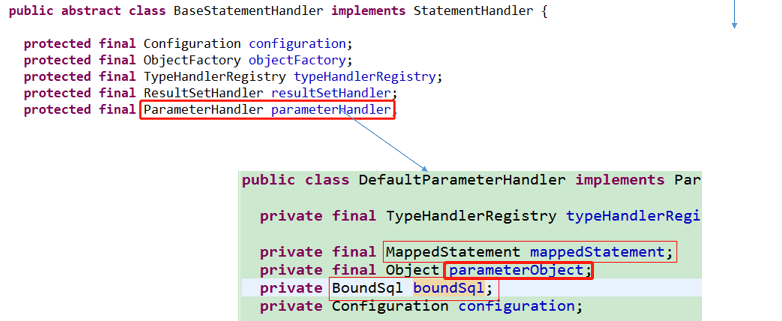
关键代码
//拿到target的元数据
MetaObject metaObject = SystemMetaObject.forObject(target);
Object value = metaObject.getValue("parameterHandler.parameterObject");
插件:MySecondPlugin
@Intercepts(
{
@Signature(type=StatementHandler.class,method="parameterize",args=java.sql.Statement.class)
})
public class MySecondPlugin implements Interceptor{
@Override
public Object intercept(Invocation invocation) throws Throwable {
System.out.println("MySecondPlugin...intercept:"+invocation.getMethod());
return invocation.proceed();
}
@Override
public Object plugin(Object target) {
// TODO Auto-generated method stub
System.out.println("MySecondPlugin...plugin:"+target);
return Plugin.wrap(target, this);
}
@Override
public void setProperties(Properties properties) {
// TODO Auto-generated method stub
}
}
<!--plugins:注册插件 -->
<plugins>
<plugin interceptor="com.atguigu.mybatis.dao.MyFirstPlugin">
<property name="username" value="root"/>
<property name="password" value="123123"/>
</plugin>
<plugin interceptor="com.atguigu.mybatis.dao.MySecondPlugin"></plugin>
</plugins>
PageHelper插件
PageHelper是MyBatis中非常方便的第三方分页插件
官方文档:https://github.com/pagehelper/Mybatis-PageHelper/blob/master/wikis/zh/HowToUse.md
使用步骤:
-
导入相关jar包(也可以用maven)

-
在MyBatis全局配置文件中配置分页插件
<plugins> <!-- com.github.pagehelper为PageHelper类所在包名 --> <plugin interceptor="com.github.pagehelper.PageInterceptor"> <!-- 使用下面的方式配置参数,后面会有所有的参数介绍 --> <property name="param1" value="value1"/> </plugin> </plugins> -
在 Spring 配置文件中配置拦截器插件
<bean id="sqlSessionFactory" class="org.mybatis.spring.SqlSessionFactoryBean"> <!-- 注意其他配置 --> <property name="plugins"> <array> <bean class="com.github.pagehelper.PageInterceptor"> <property name="properties"> <!--使用下面的方式配置参数,一行配置一个 --> <value> params=value1 </value> </property> </bean> </array> </property> </bean> -
使用PageHelper提供的方法进行分页
//param pageNum 页码 //param pageSize 每页显示数量 public static <E> Page<E> startPage(int pageNum, int pageSize)示例
@Test public void test01() throws Exception { SqlSessionFactory sqlSessionFactory = getSqlSessionFactory(); SqlSession openSession = sqlSessionFactory.openSession(); EmployeeMapper mapper = openSession.getMapper(EmployeeMapper.class); // 第二种,Mapper接口方式的调用,推荐这种使用方式。 Page<Object> page = PageHelper.startPage(2, 5); List<Employee> emps = mapper.getEmps(); for (Employee employee : emps) { System.out.println(employee); } System.out.println("当前页码:" + page.getPageNum()); System.out.println("总记录数:" + page.getTotal()); }结果
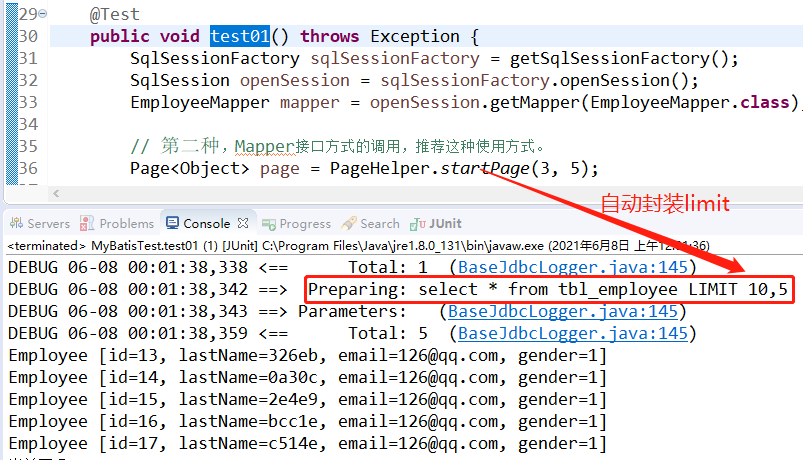
pageinfo对象,功能强大,传入page结果集和页码数量,返回导航条页码
PageInfo<Employee> info = new PageInfo<Employee>(emps, 5)
/**
* 包装Page对象
* @param list page结果
* @param navigatePages 页码数量
*/
public PageInfo(List<T> list, int navigatePages)
示例,结合Page<Object> page = PageHelper.startPage(3, 5)一起用
@Test
public void test02() throws Exception {
SqlSessionFactory sqlSessionFactory = getSqlSessionFactory();
SqlSession openSession = sqlSessionFactory.openSession();
EmployeeMapper mapper = openSession.getMapper(EmployeeMapper.class);
Page<Object> page = PageHelper.startPage(3, 5);
List<Employee> emps = mapper.getEmps();
PageInfo<Employee> info = new PageInfo<Employee>(emps, 5);
System.out.println("当前页码:" + info.getPageNum());
System.out.println("总记录数:" + info.getTotal());
System.out.println("每页的记录数:" + info.getPageSize());
System.out.println("总页码:" + info.getPages());
System.out.println("是否第一页:" + info.isIsFirstPage());
System.out.println("连续显示的页码:");
System.out.println();
int[] nums = info.getNavigatepageNums();
for (int i = 0; i < nums.length; i++) {
System.out.println(nums[i]);
}
}
批量操作
- 默认的 openSession() 方法没有参数,它会创建有如下特性的
- 会开启一个事务(也就是不自动提交)
- 连接对象会从由活动环境配置的数据源实例得到。
- 事务隔离级别将会使用驱动或数据源的默认设置。
- 预处理语句不会被复用,也不会批量处理更新。
- openSession 方法的 ExecutorType 类型的参数,枚举类型:
- ExecutorType.SIMPLE: 这个执行器类型不做特殊的事情(这是默认装配 的)。它为每个语句的执行创建一个新的预处理语句。
- ExecutorType.REUSE: 这个执行器类型会复用预处理语句。
- ExecutorType.BATCH: 这个执行器会批量执行所有更新语句
- 批量操作我们是使用MyBatis提供的BatchExecutor进行的, 他的底层就是通过jdbc攒sql的方式进行的。我们可以让他 攒够一定数量后发给数据库一次
@Test
public void test03() throws IOException {
SqlSessionFactory sqlSessionFactory = getSqlSessionFactory();
SqlSession openSession = sqlSessionFactory.openSession(ExecutorType.BATCH);
EmployeeMapper mapper = openSession.getMapper(EmployeeMapper.class);
long startTime = System.currentTimeMillis();
try {
for (int i = 1; i < 10000; i++) {
mapper.addEmp(new Employee(UUID.randomUUID().toString().substring(0, 5), "126@qq.com", "1"));
}
openSession.commit();
long endTime = System.currentTimeMillis();
System.out.println(endTime - startTime);
} finally {
if (openSession != null)
openSession.close();
}
}
-
与Spring整合中,我们推荐,额外的配置一个可以专门用来执行批量操作的sqlSession

-
需要用到批量操作的时候,我们可以注入配置的这个批量SqlSession。通过他获取到mapper映射器进行操作。
注意:
- 批量操作是在session.commit()以后才发送sql语句给数据库进行执行的
- 如果我们想让其提前执行,以方便后续可能的查询操作获取数据,我们可以使sqlSession.flushStatements()方法,让其直接冲刷到数据库进行执行。
自定义TypeHandler类型处理器
使用mybatis自带的类型处理器
handler="org.apache.ibatis.type.EnumTypeHandler"
mybatis在处理枚举对象的时候默认保存的是枚举的名字:
全局配置:
<typeHandlers>
<typeHandler handler="org.apache.ibatis.type.EnumTypeHandler" javaType="com.atguigu.mybatis.bean.EmpStatus"/>
</typeHandlers>
枚举类实例
public enum EmpStatus {
LOGIN, LOGOUT, REMOVE
}
在Employee类中引入枚举类
public class Employee {
private Integer id;
private String lastName;
private String email;
private String gender;
//枚举类
private EmpStatus empStatus = EmpStatus.LOGOUT;
public EmpStatus getEmpStatus() {
return empStatus;
}
public void setEmpStatus(EmpStatus empStatus) {
this.empStatus = empStatus;
}
Mapper接口和Mapper映射文件
<!-- public void addEmp(Employee employee); -->
<insert id="addEmp" parameterType="com.atguigu.mybatis.bean.Employee" useGeneratedKeys="true" keyProperty="id">
insert tbl_employee(last_name,email,gender,empStatus) values(#{lastName},#{email},#{gender},#{empStatus})
</insert>
测试
@Test
public void testEnum() throws IOException {
SqlSessionFactory sqlSessionFactory = getSqlSessionFactory();
SqlSession openSession = sqlSessionFactory.openSession();
try {
EmployeeMapper mapper = openSession.getMapper(EmployeeMapper.class);
Employee emp = new Employee("test_enum", "enum@atguigu.com", "1");
mapper.addEmp(emp);
openSession.commit();
System.out.println("插入成功:" + emp.getId());
} finally {
if (openSession != null)
openSession.close();
}
}
测试结果:

若想改变TypeHandler的类型,在全局配置文件修改设置,其他bean,dao,Mapper映射文件一样
<typeHandlers>
<typeHandler
handler="org.apache.ibatis.type.EnumOrdinalTypeHandler"
javaType="com.atguigu.mybatis.bean.EmpStatus" />
</typeHandlers>
测试结果
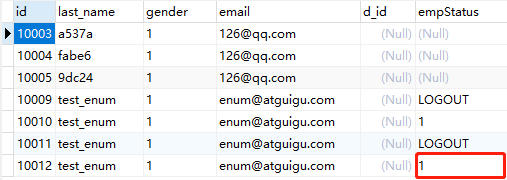
自定义TypeHandler处理器
步骤
-
实现TypeHandler接口。或者继承BaseTypeHandler
public class MyEnumEmpStatusTypeHandler implements TypeHandler<EmpStatus> { /** * 定义当前数据如何保存到数据库中 */ @Override public void setParameter(PreparedStatement ps, int i, EmpStatus parameter, JdbcType jdbcType) throws SQLException { // TODO Auto-generated method stub System.out.println("要保存的状态码:"+parameter.getCode()); ps.setString(i, parameter.getCode().toString()); } @Override public EmpStatus getResult(ResultSet rs, String columnName) throws SQLException { // TODO Auto-generated method stub //需要根据从数据库中拿到的枚举的状态码返回一个枚举对象 int code = rs.getInt(columnName); System.out.println("从数据库中获取的状态码:"+code); EmpStatus status = EmpStatus.getEmpStatusByCode(code); return status; } @Override public EmpStatus getResult(ResultSet rs, int columnIndex) throws SQLException { // TODO Auto-generated method stub int code = rs.getInt(columnIndex); System.out.println("从数据库中获取的状态码:"+code); EmpStatus status = EmpStatus.getEmpStatusByCode(code); return status; } @Override public EmpStatus getResult(CallableStatement cs, int columnIndex) throws SQLException { // TODO Auto-generated method stub int code = cs.getInt(columnIndex); System.out.println("从数据库中获取的状态码:"+code); EmpStatus status = EmpStatus.getEmpStatusByCode(code); return status; } } -
编写枚举类
public enum EmpStatus { LOGIN(100, "用户登录"), LOGOUT(200, "用户登出"), REMOVE(300, "用户不存在"); private Integer code; private String msg; private EmpStatus(Integer code, String msg) { this.code = code; this.msg = msg; } public Integer getCode() { return code; } public void setCode(Integer code) { this.code = code; } public String getMsg() { return msg; } public void setMsg(String msg) { this.msg = msg; } public static EmpStatus getEmpStatusByCode(Integer code) { switch (code) { case 100: return LOGIN; case 200: return LOGOUT; case 300: return REMOVE; default: return LOGIN; } } } -
全局配置文件,或者在处理某个字段的时候告诉MyBatis用什么类型处理器
<typeHandlers> <typeHandler handler="com.atguigu.mybatis.typehandler.MyEnumEmpStatusTypeHandler" javaType="com.atguigu.mybatis.bean.EmpStatus" /> </typeHandlers><!--2、也可以在处理某个字段的时候告诉MyBatis用什么类型处理器 保存:#{empStatus,typeHandler=xxxx} 查询: <resultMap type="com.atguigu.mybatis.bean.Employee" id="MyEmp"> <id column="id" property="id"/> <result column="empStatus" property="empStatus" typeHandler=""/> </resultMap> 注意:如果在参数位置修改TypeHandler,应该保证保存数据和查询数据用的TypeHandler是一样的。 --> -
测试
@Test public void testEnum() throws IOException { SqlSessionFactory sqlSessionFactory = getSqlSessionFactory(); SqlSession openSession = sqlSessionFactory.openSession(); try { EmployeeMapper mapper = openSession.getMapper(EmployeeMapper.class); Employee emp = new Employee("test_enum", "enum@atguigu.com", "1"); mapper.addEmp(emp); openSession.commit(); System.out.println("插入成功:" + emp.getId()); } finally { if (openSession != null) openSession.close(); } } -
结果
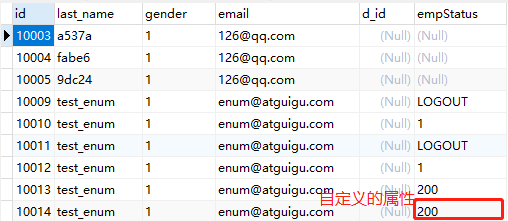
查询测试
@Test
public void testEnum02() throws IOException {
SqlSessionFactory sqlSessionFactory = getSqlSessionFactory();
SqlSession openSession = sqlSessionFactory.openSession();
try {
EmployeeMapper mapper = openSession.getMapper(EmployeeMapper.class);
Employee employee = mapper.getEmpById(10014);
EmpStatus empStatus = employee.getEmpStatus();
System.out.println(empStatus);
} finally {
if (openSession != null)
openSession.close();
}
}
查询结果
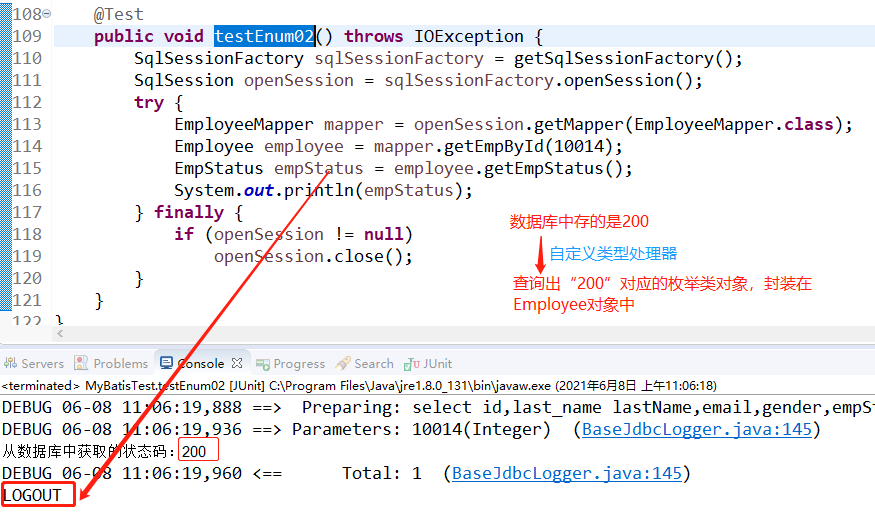

 浙公网安备 33010602011771号
浙公网安备 33010602011771号